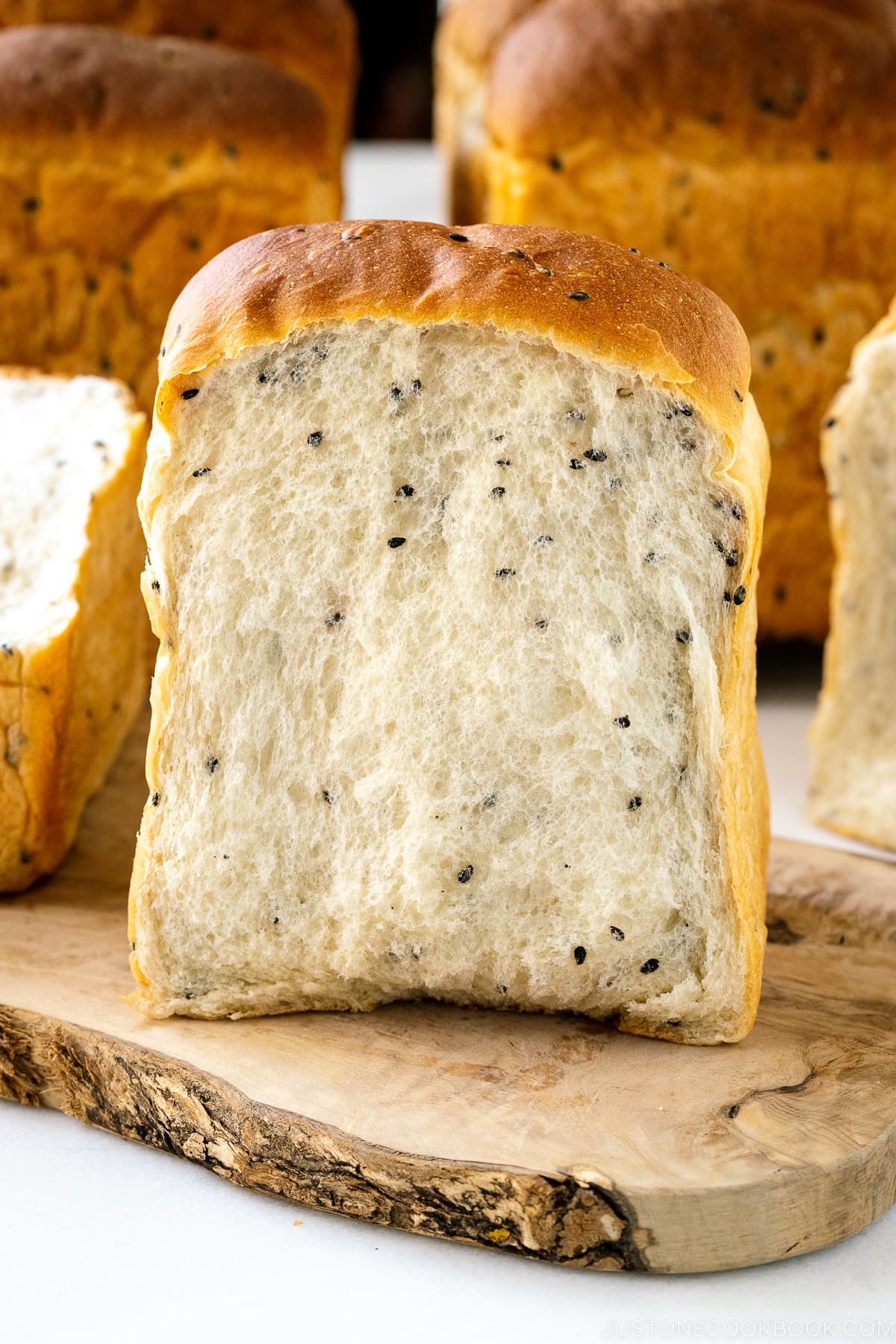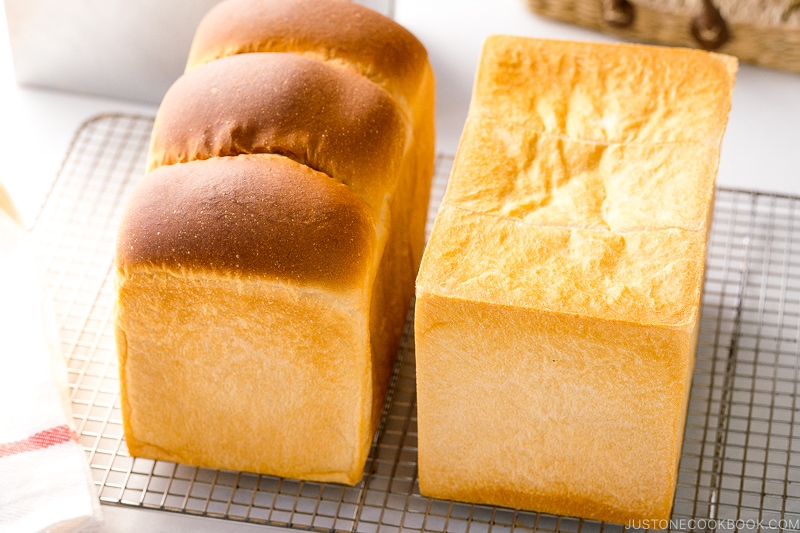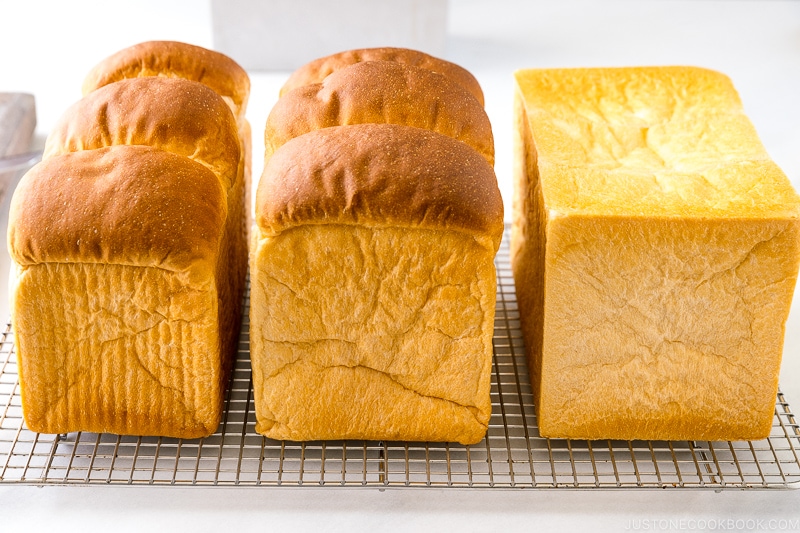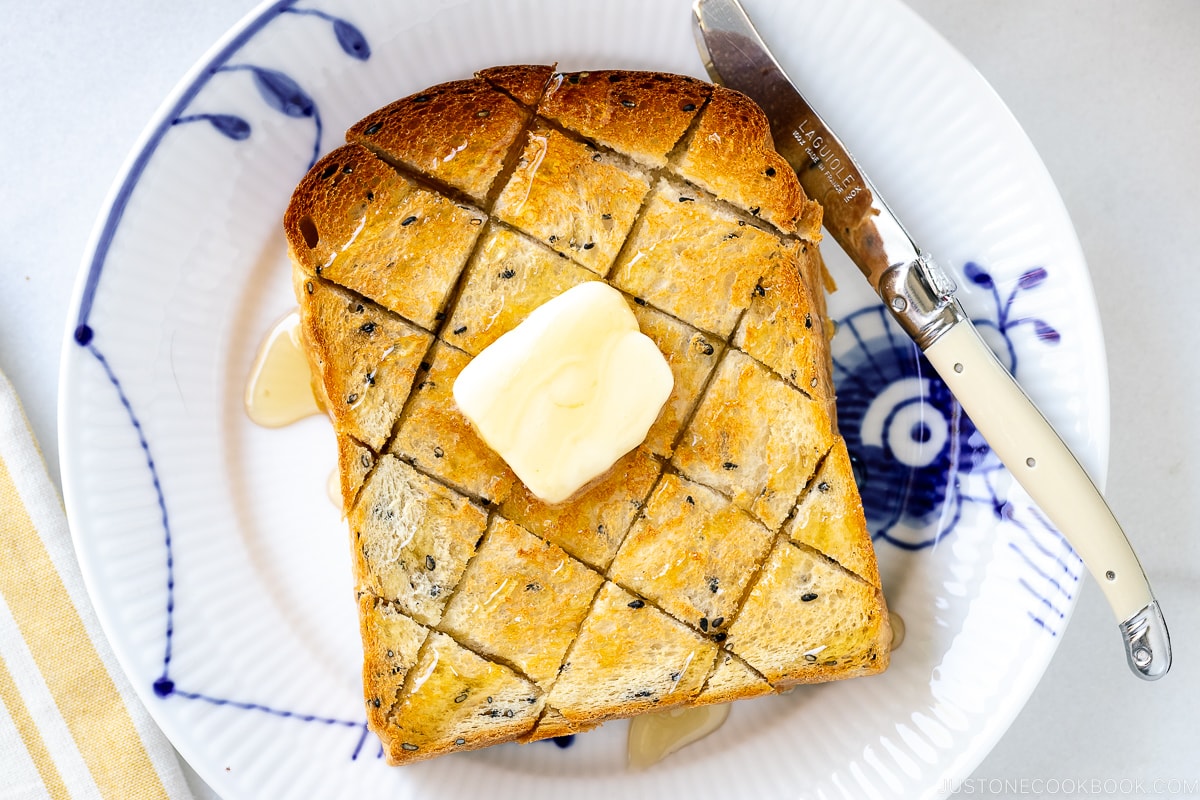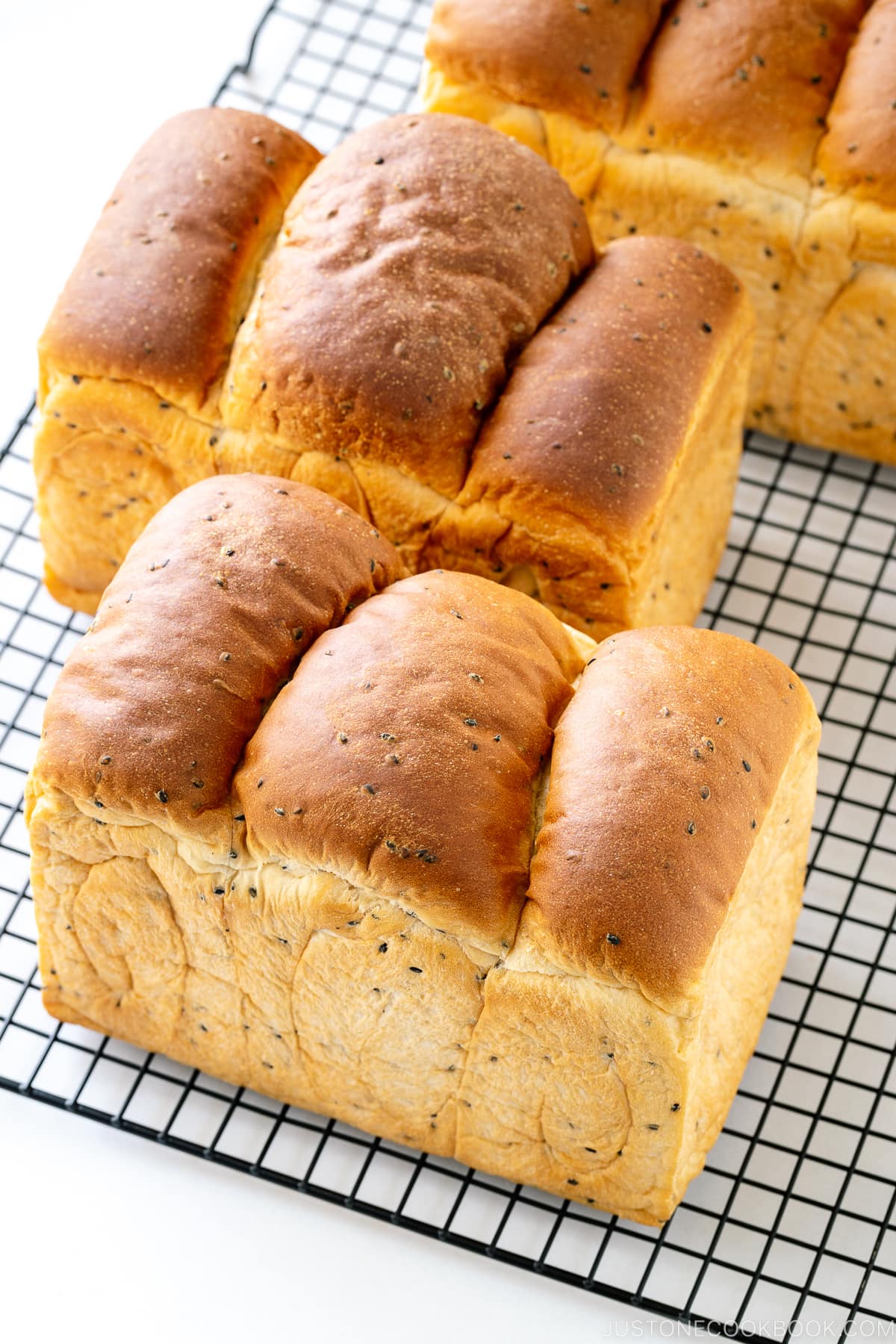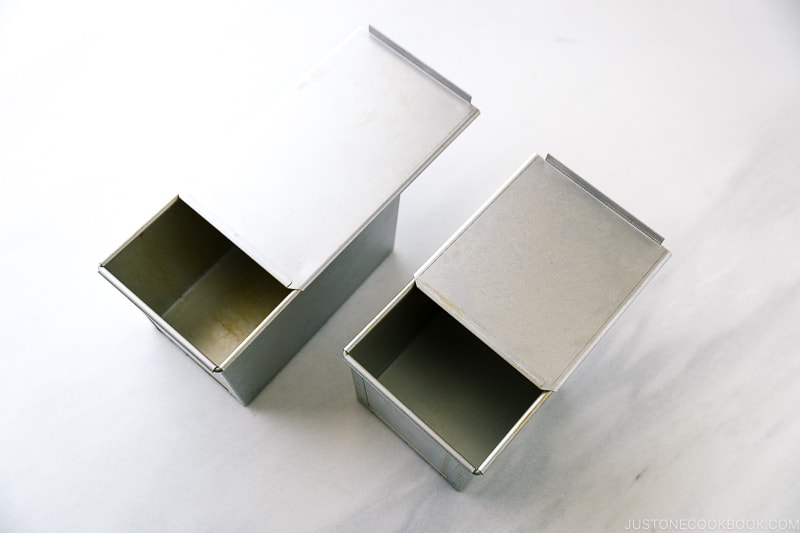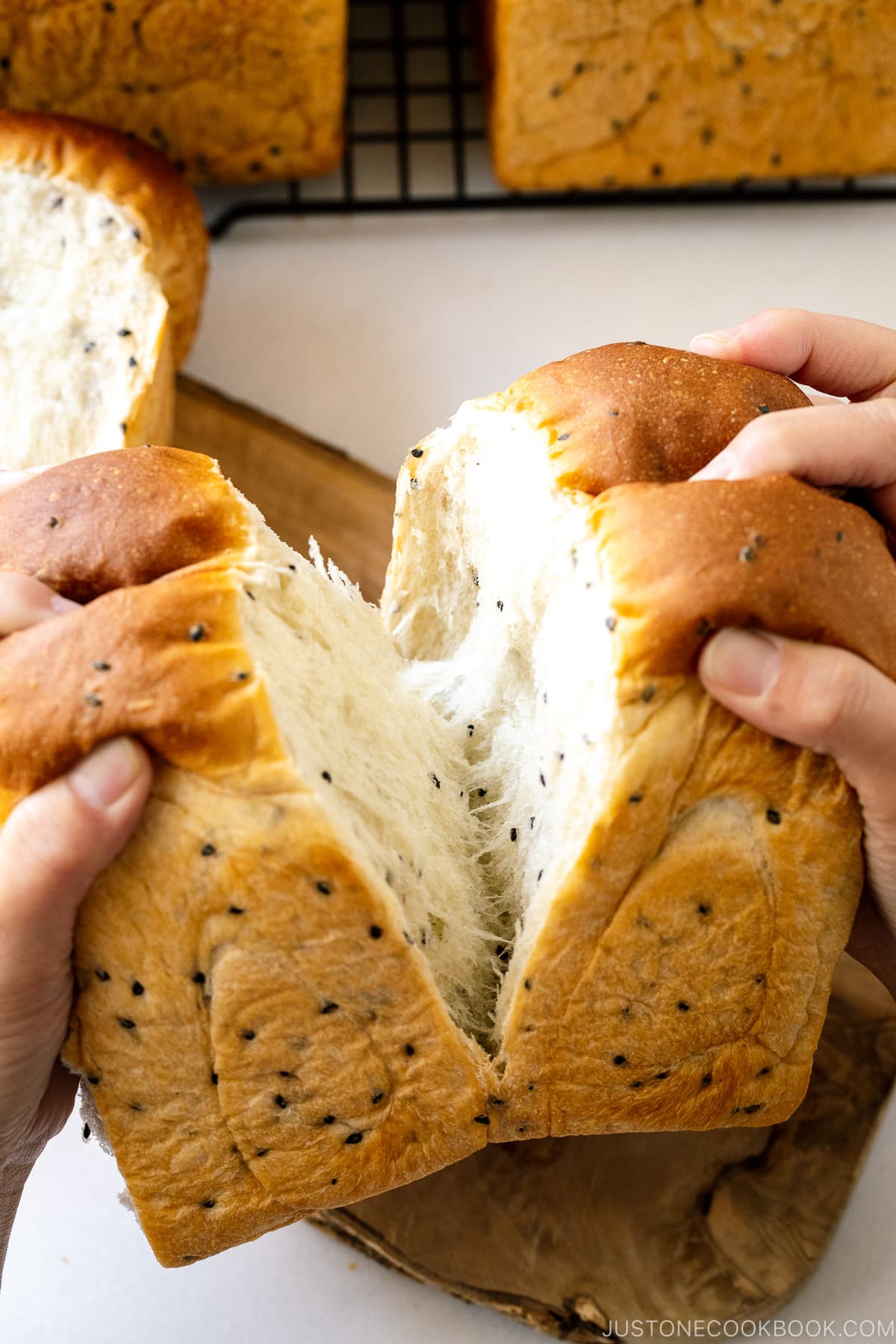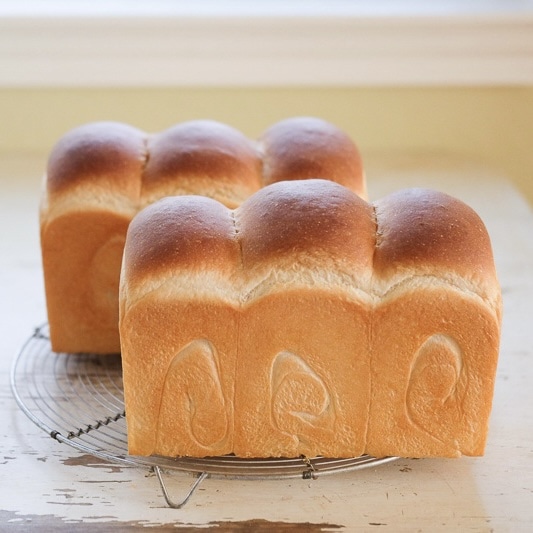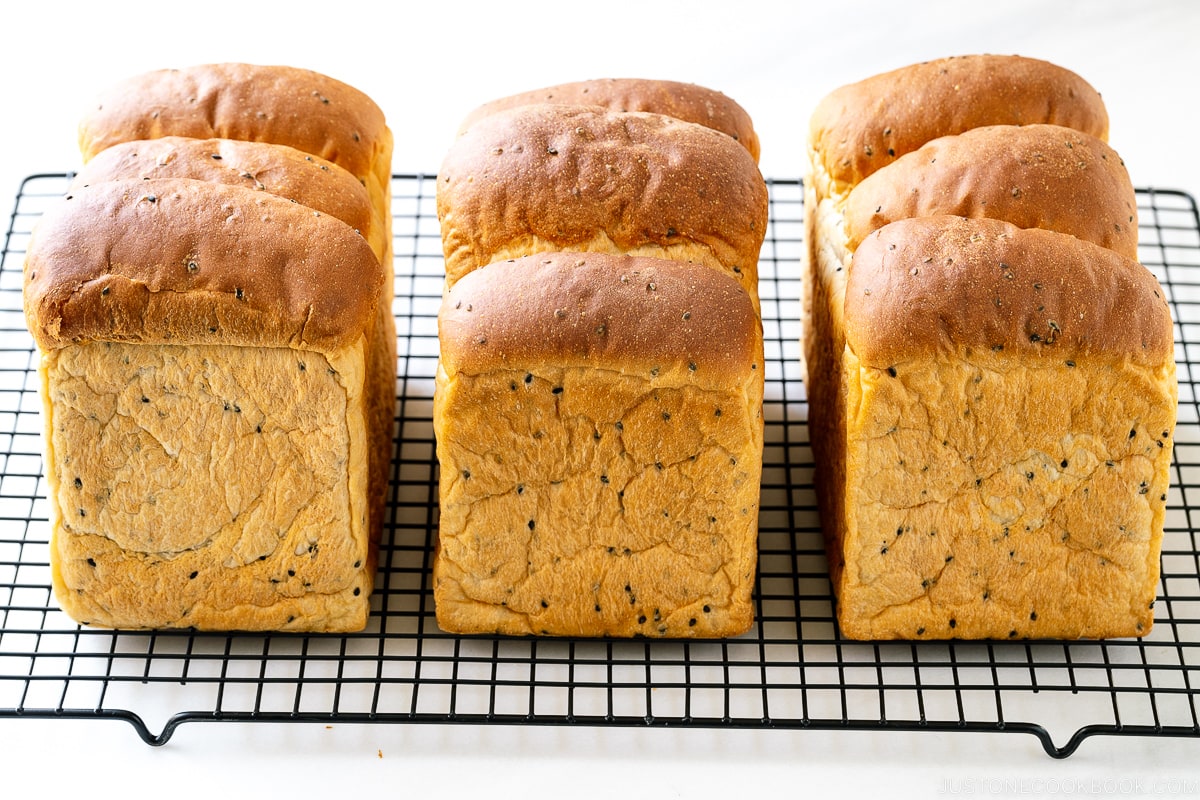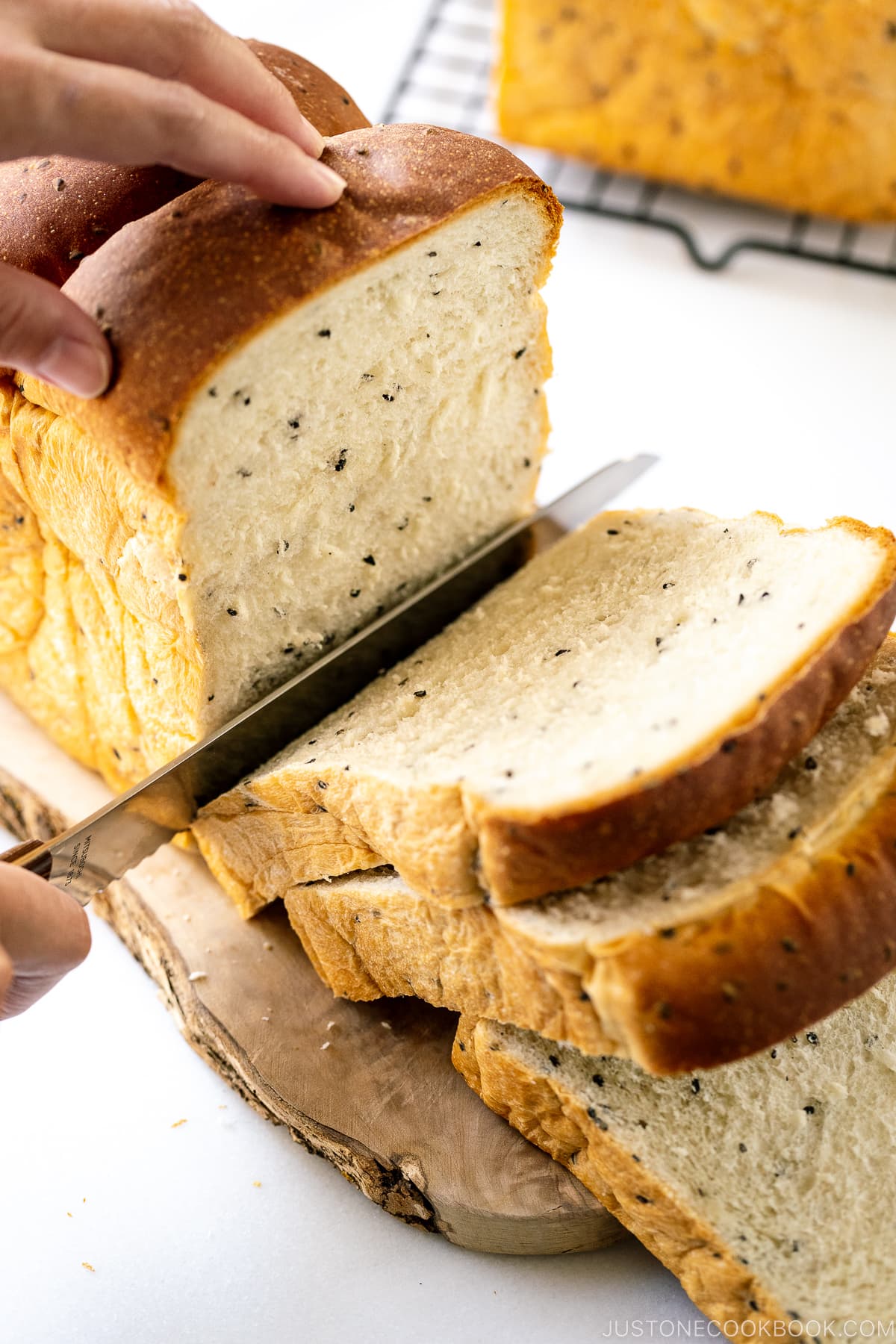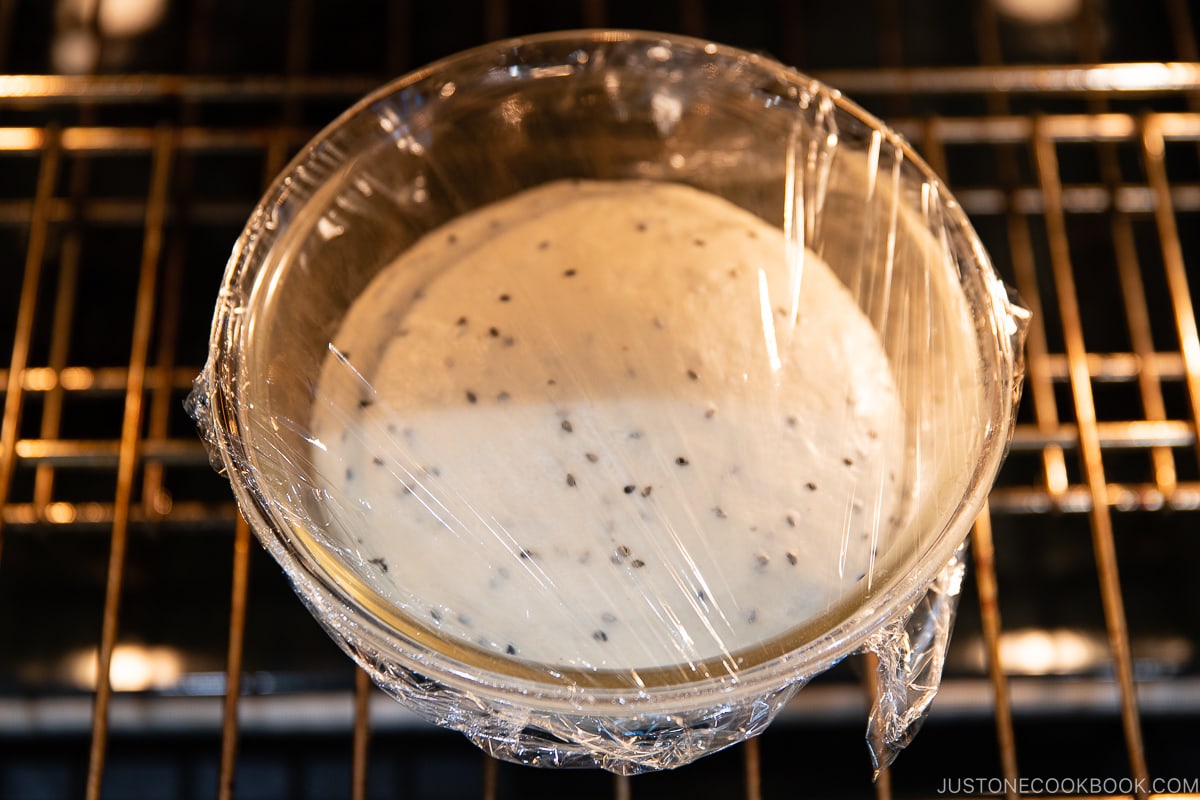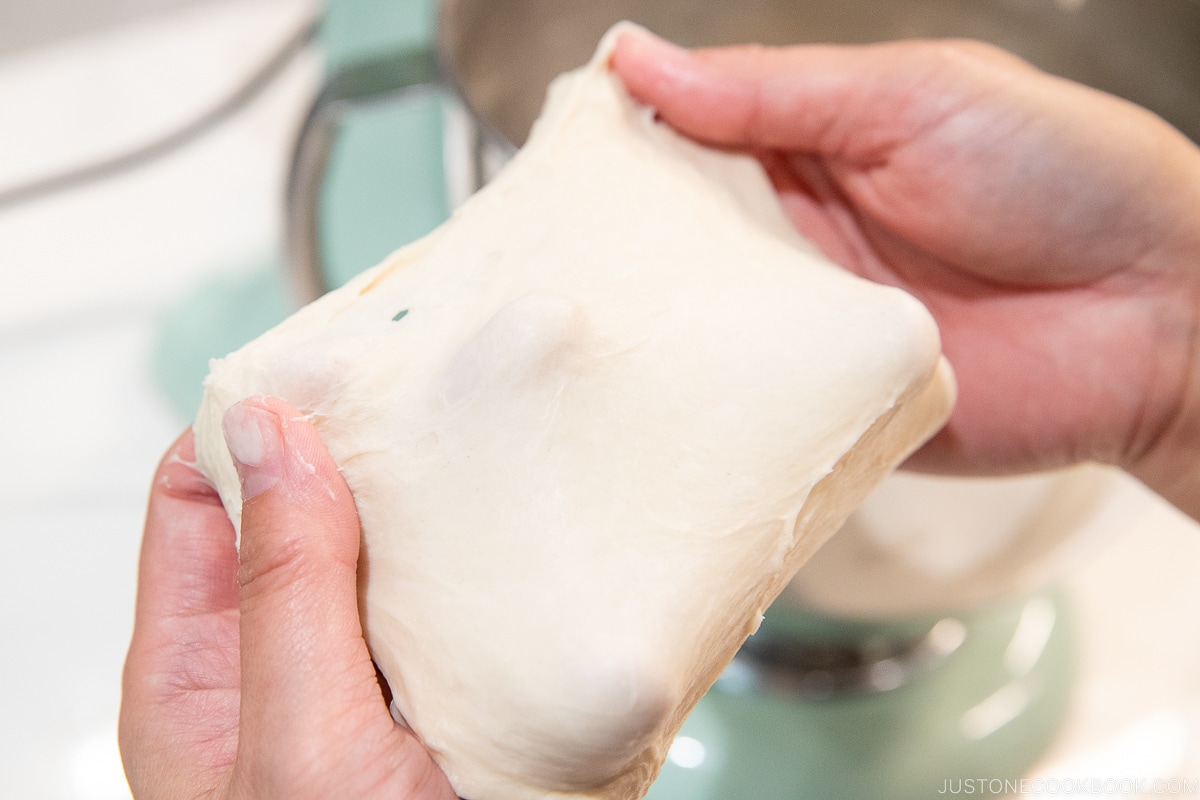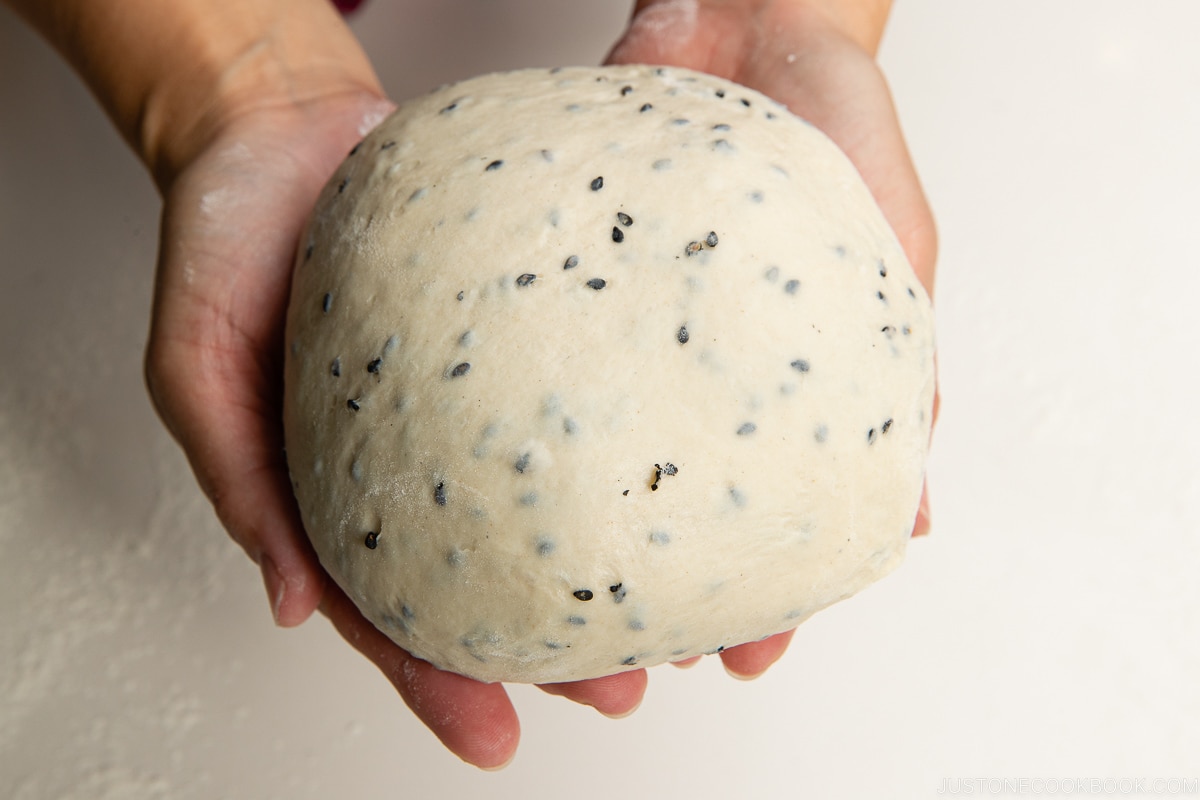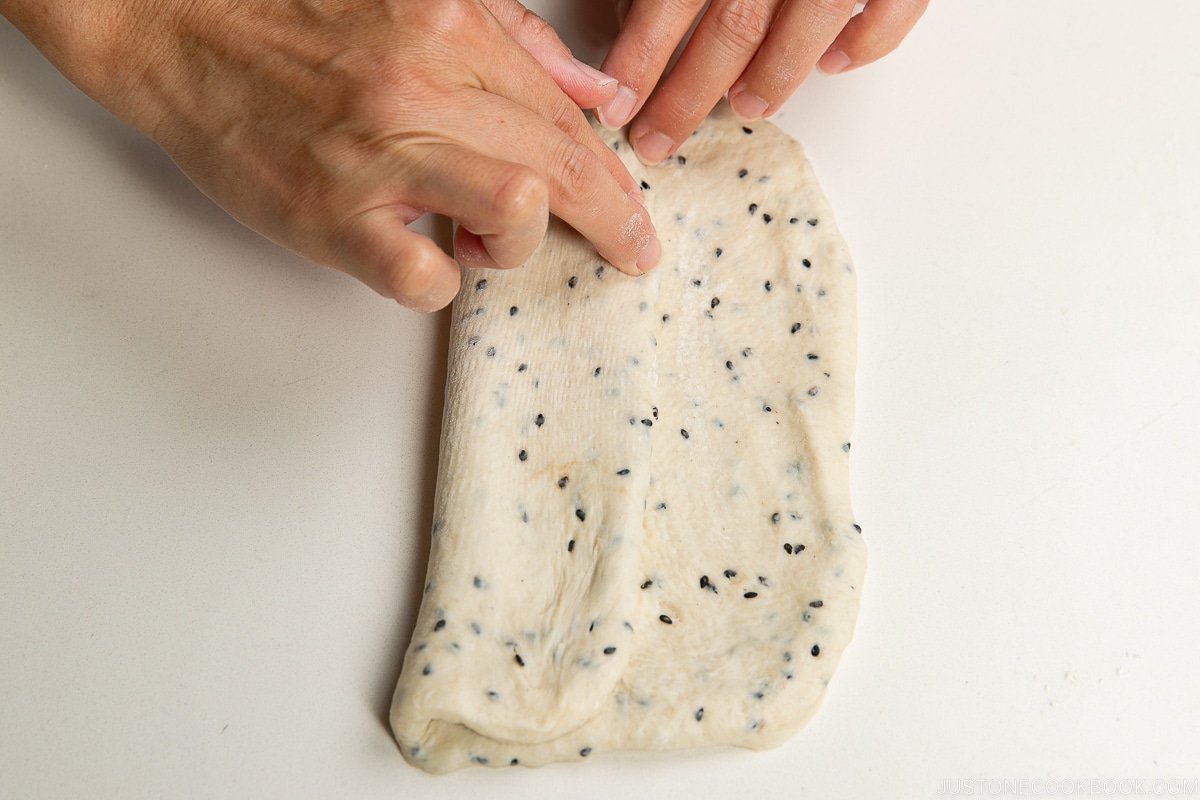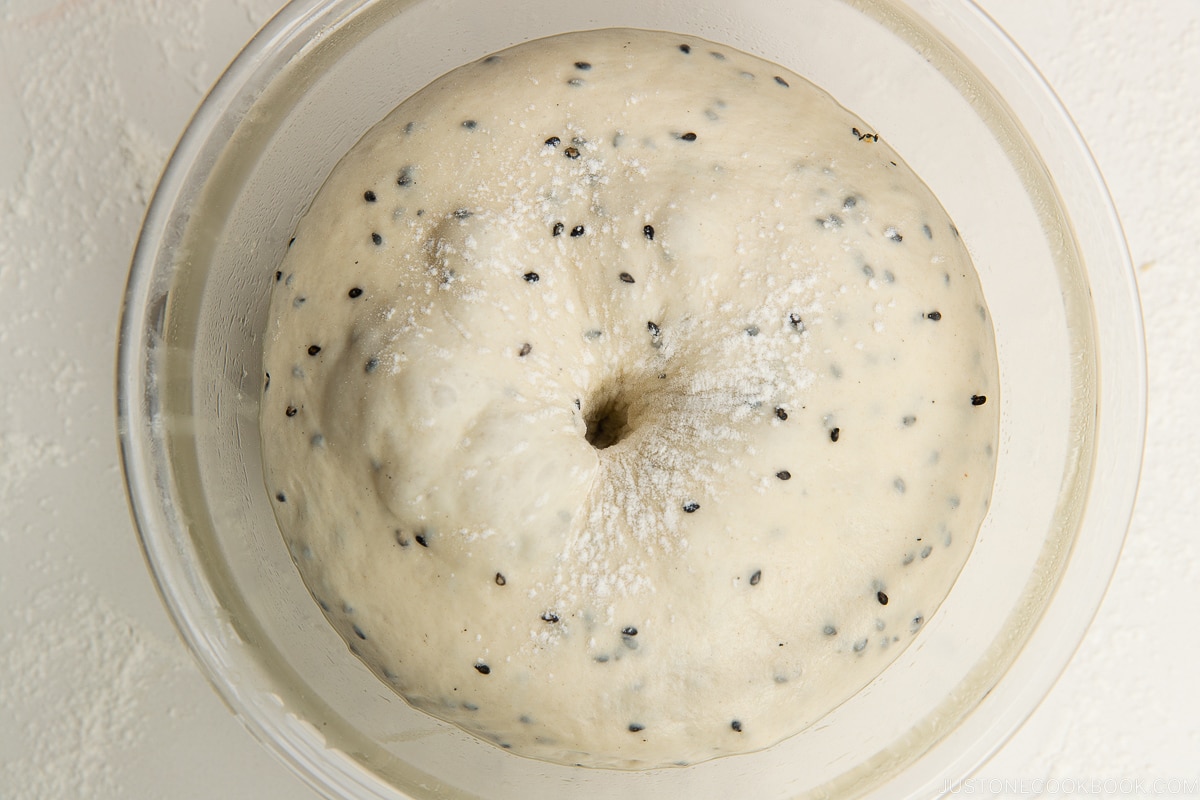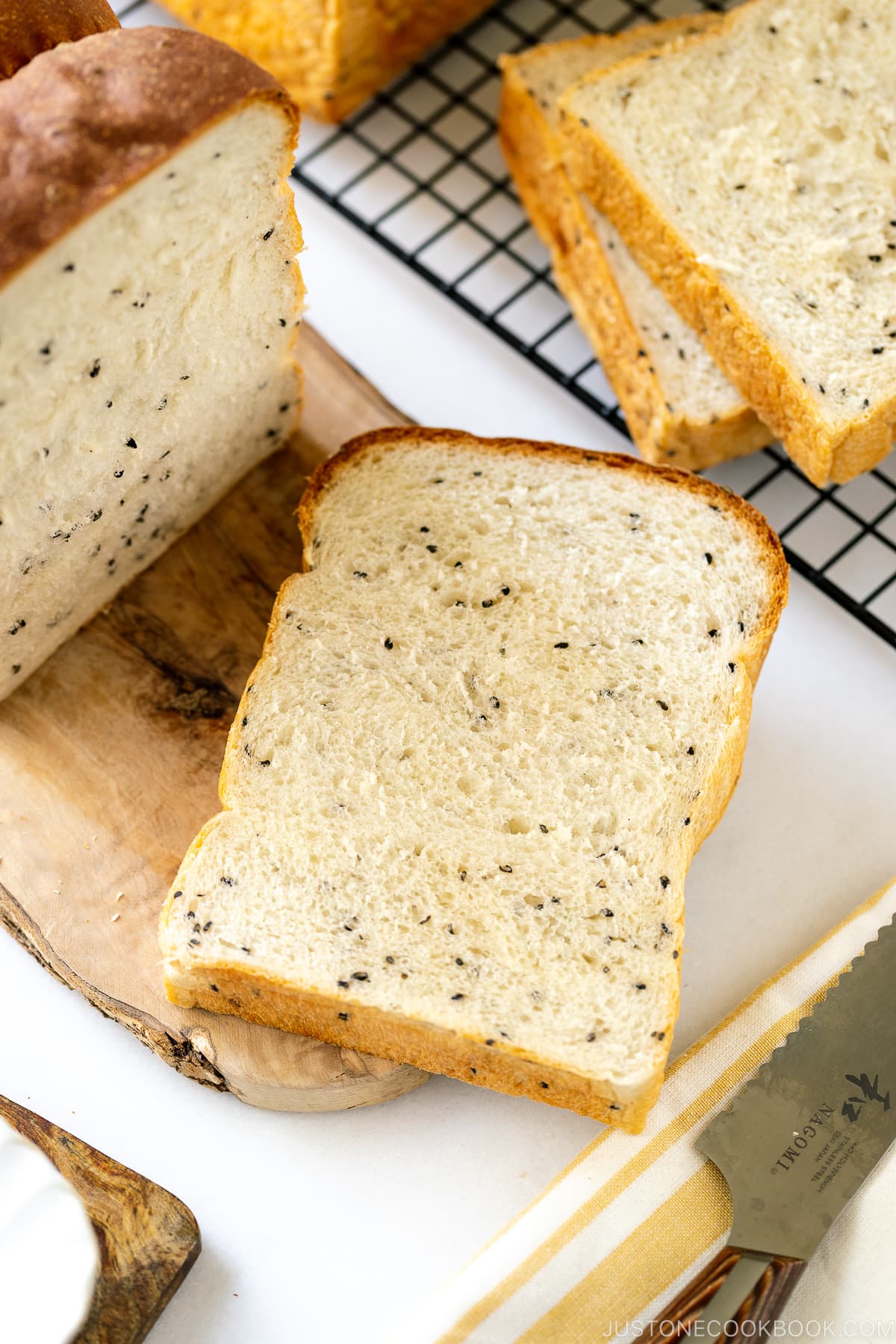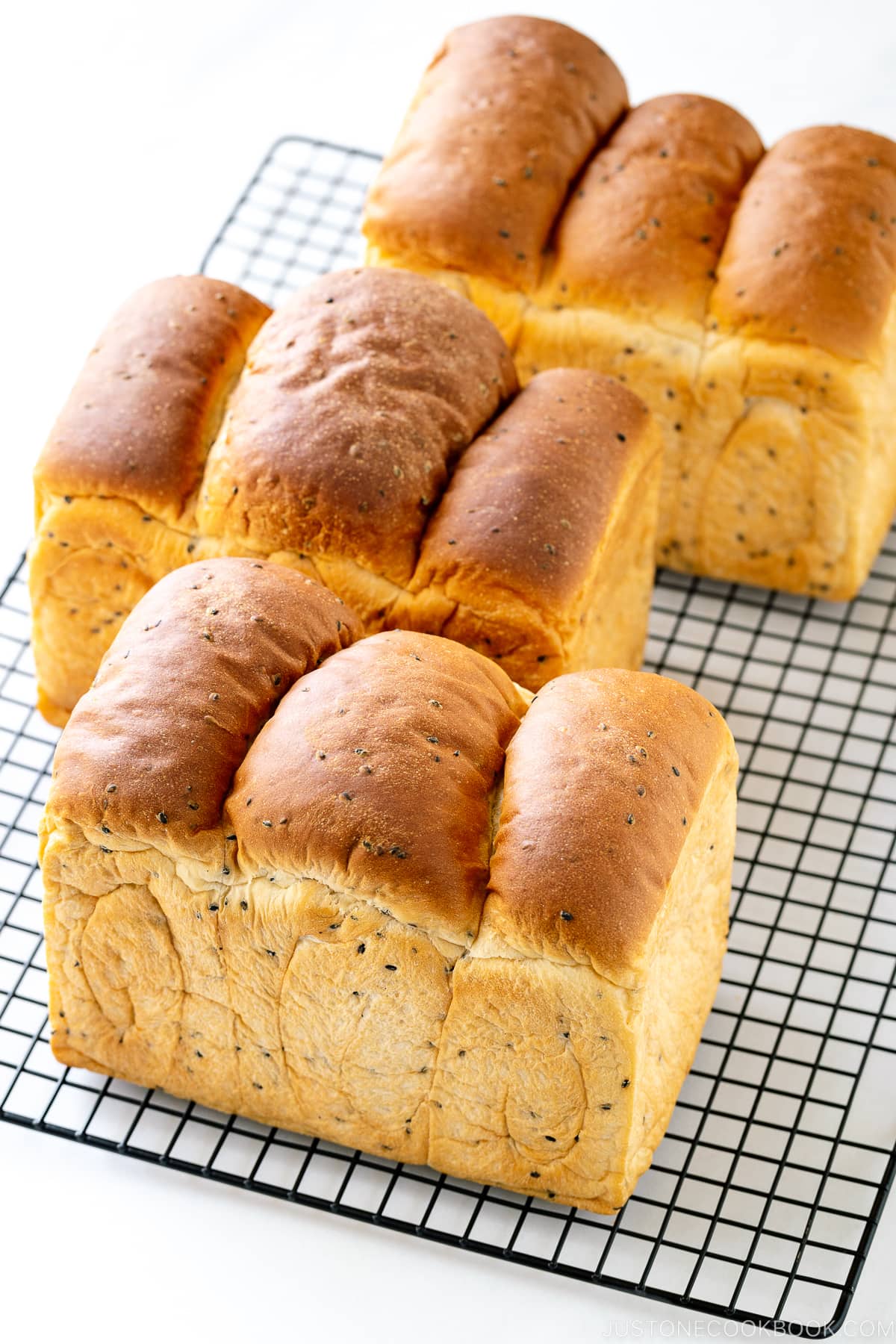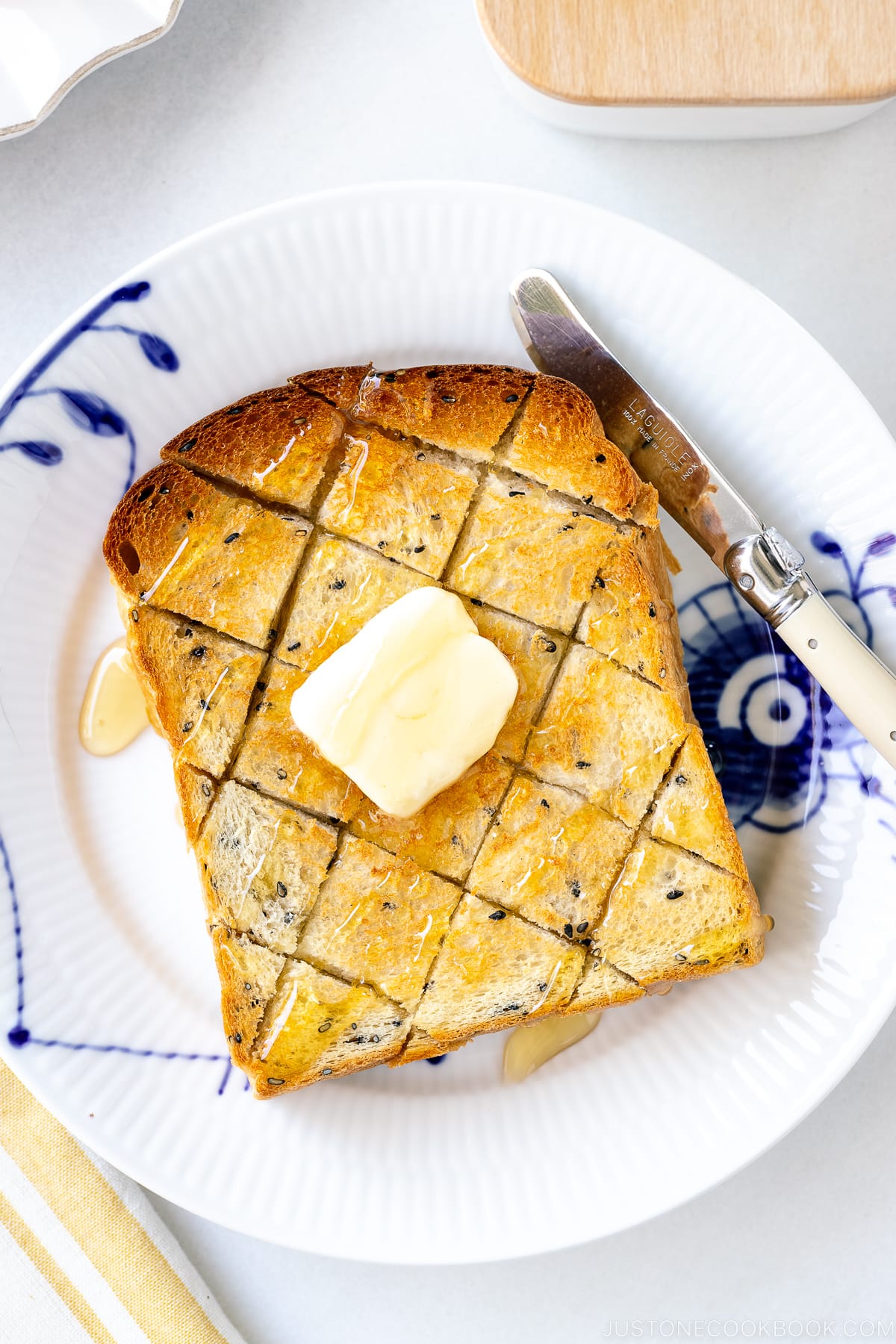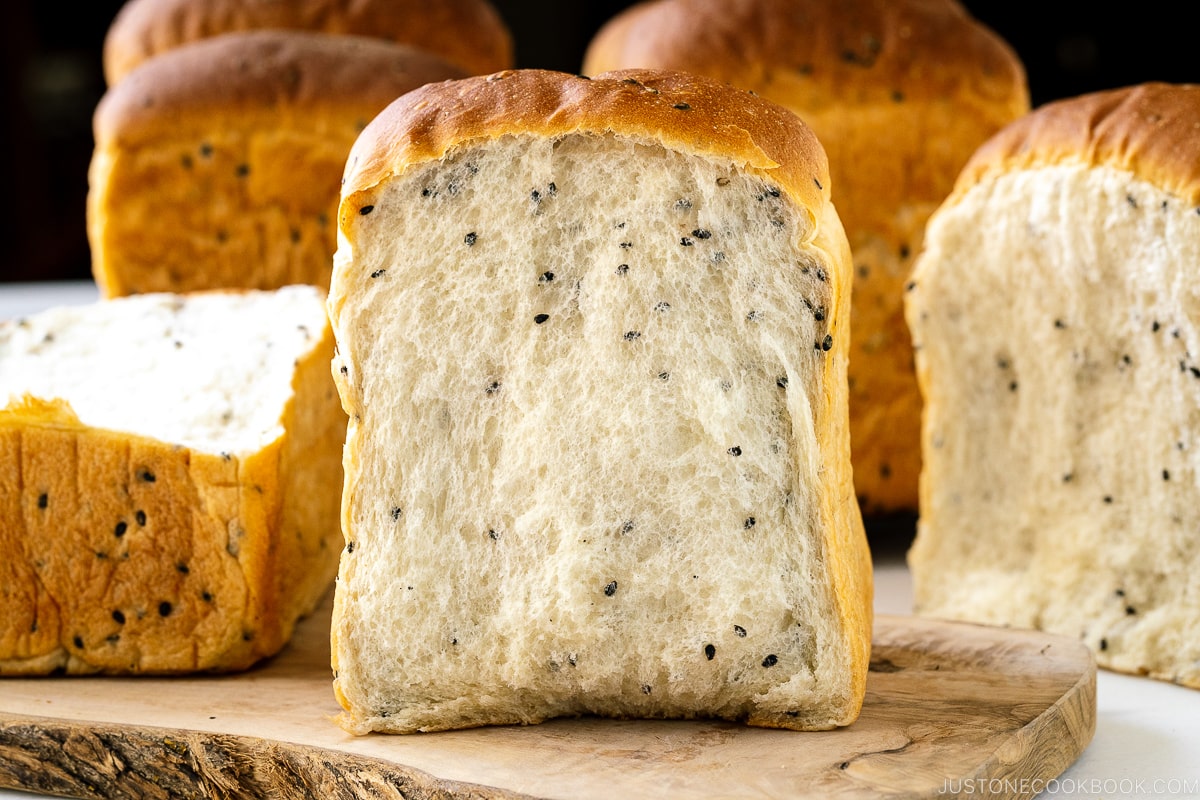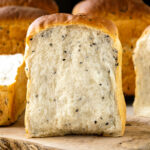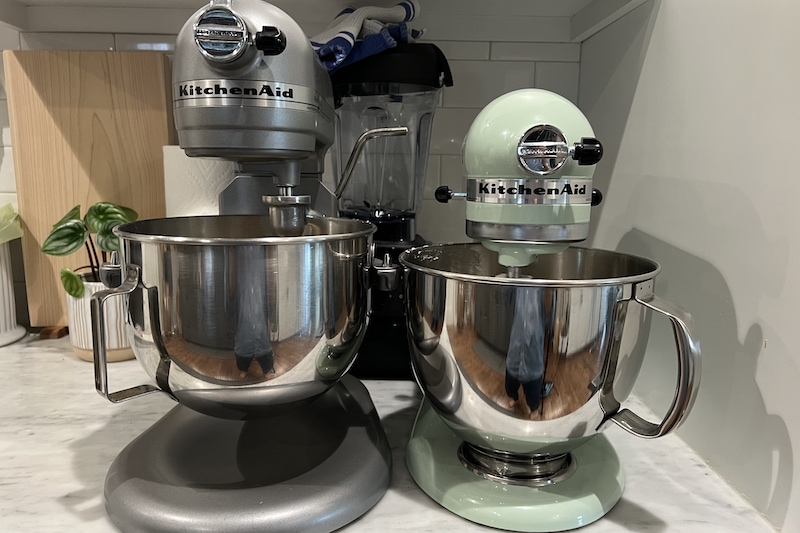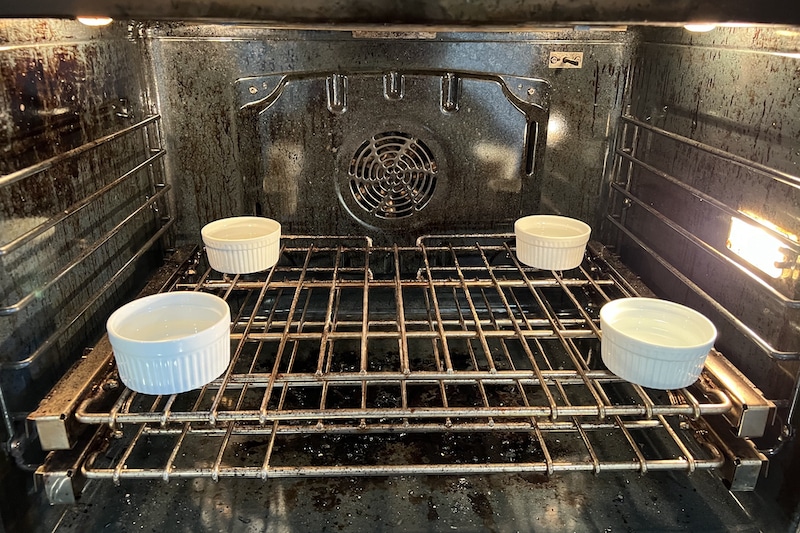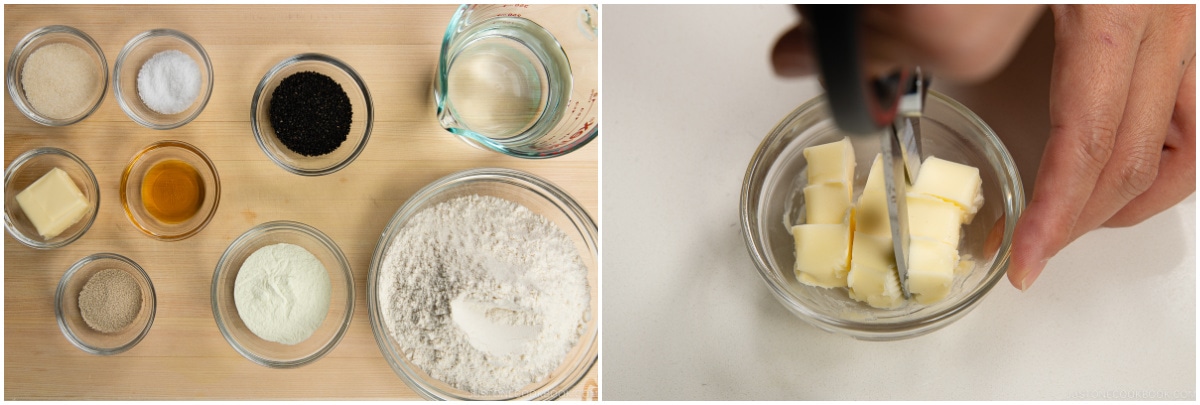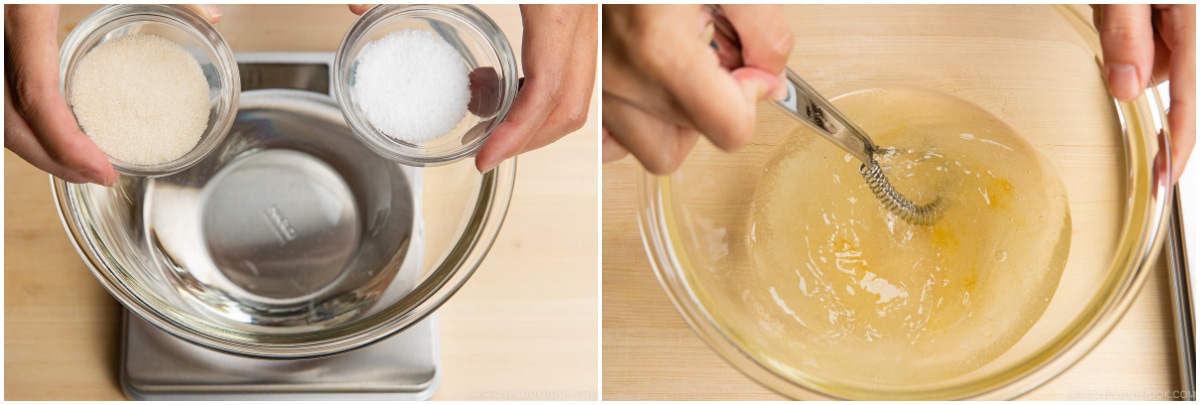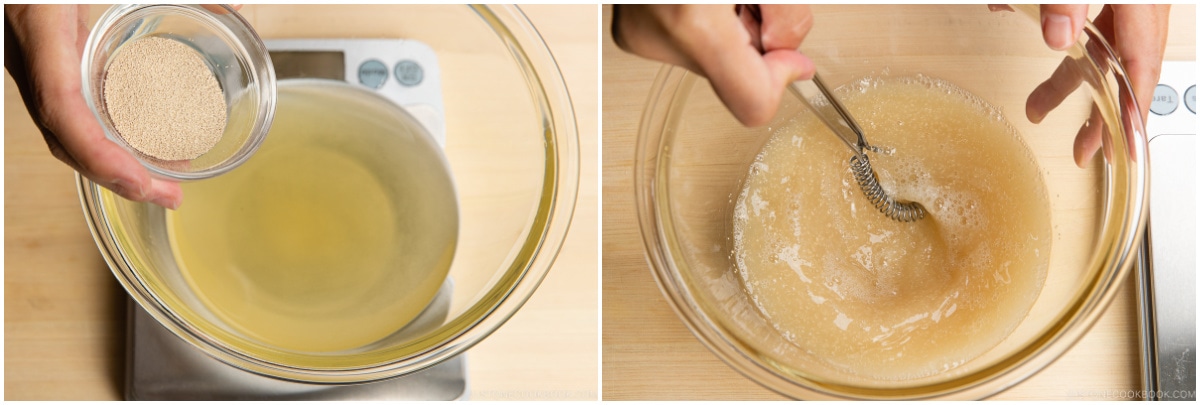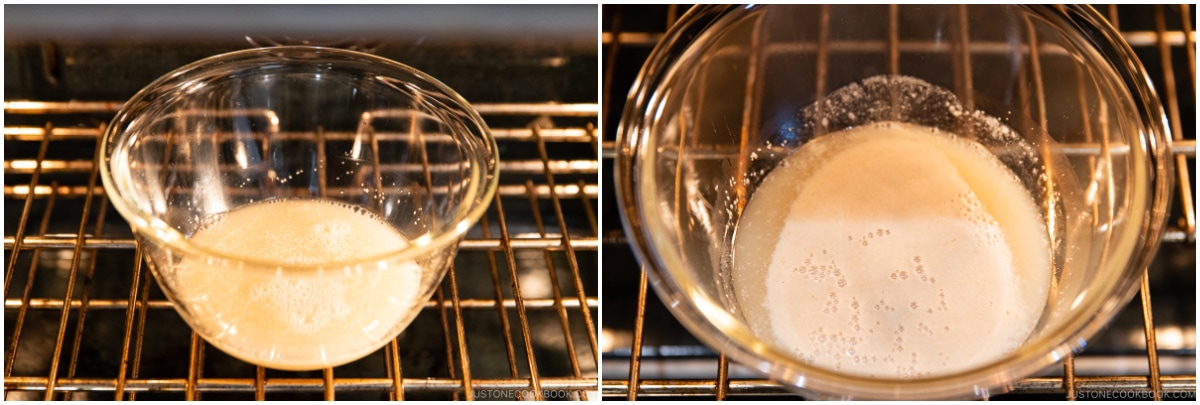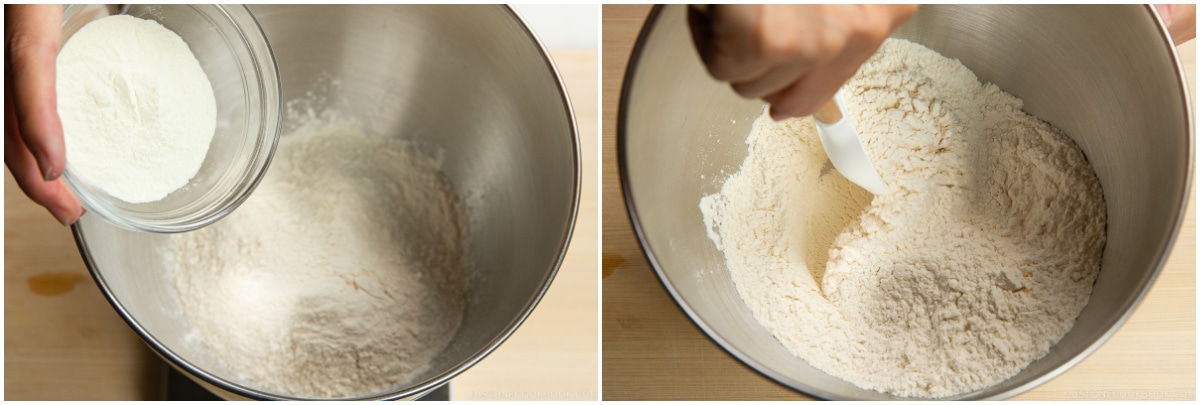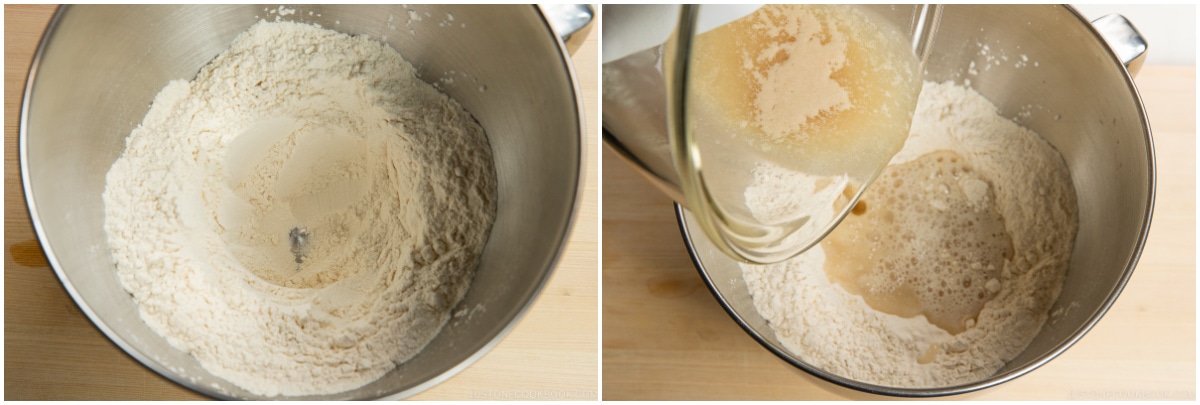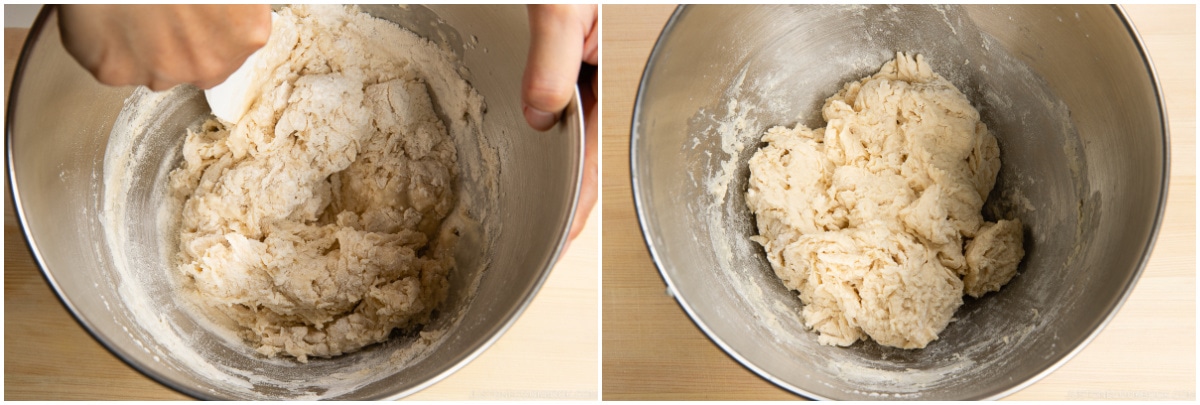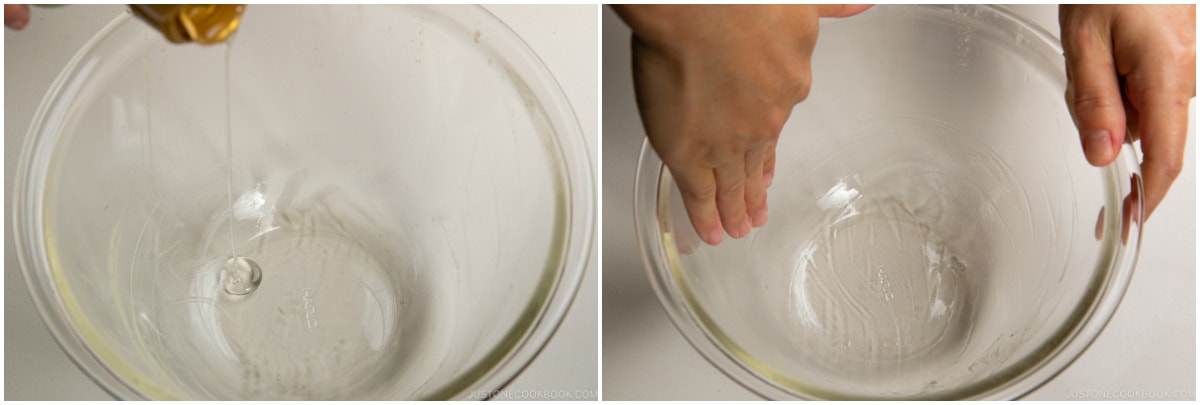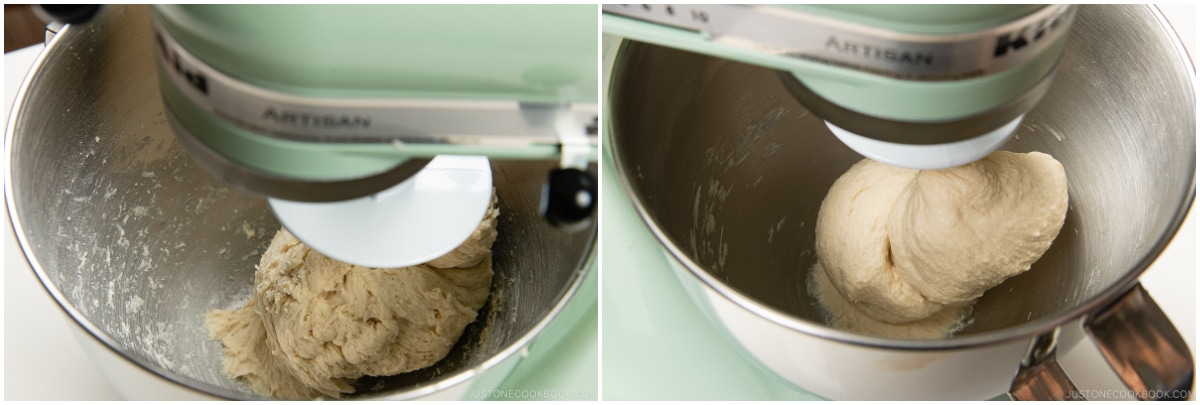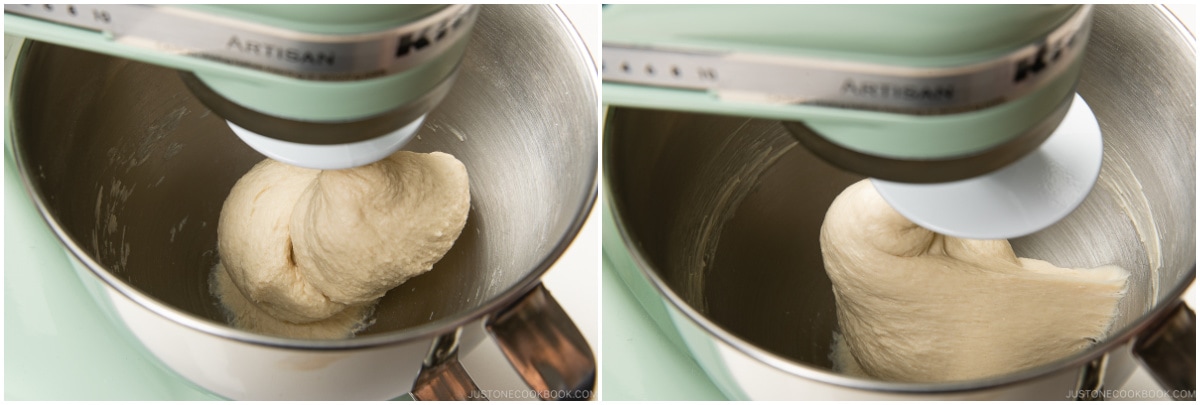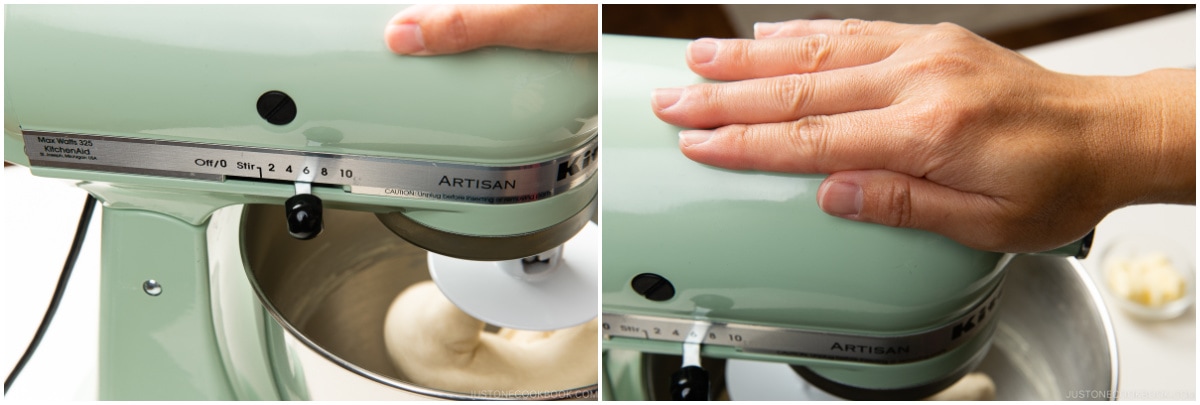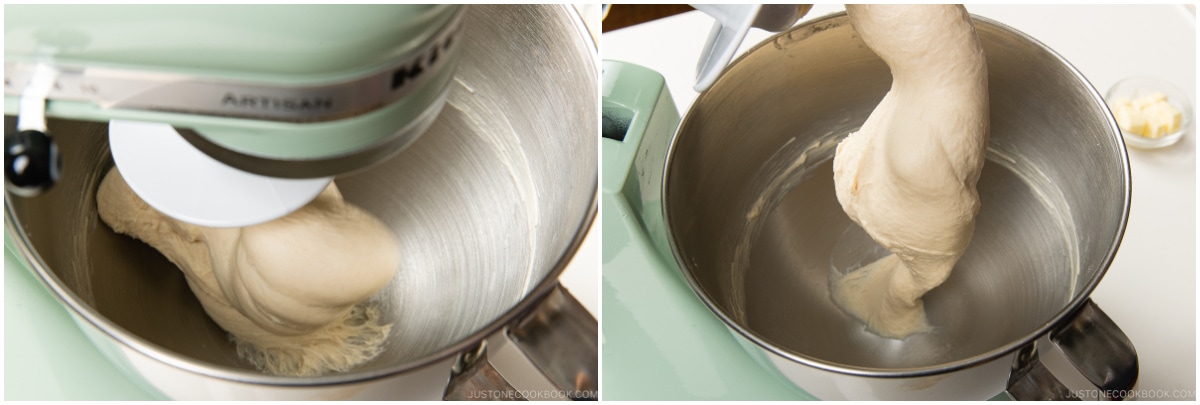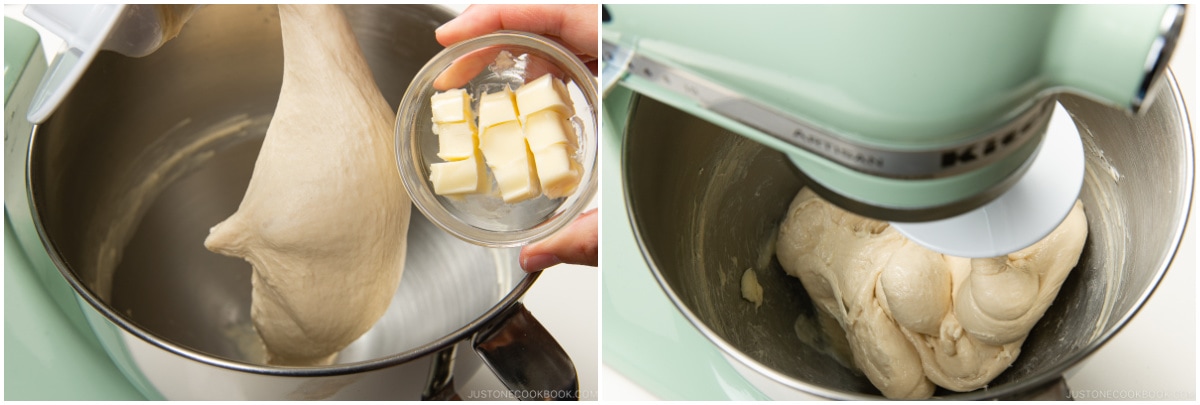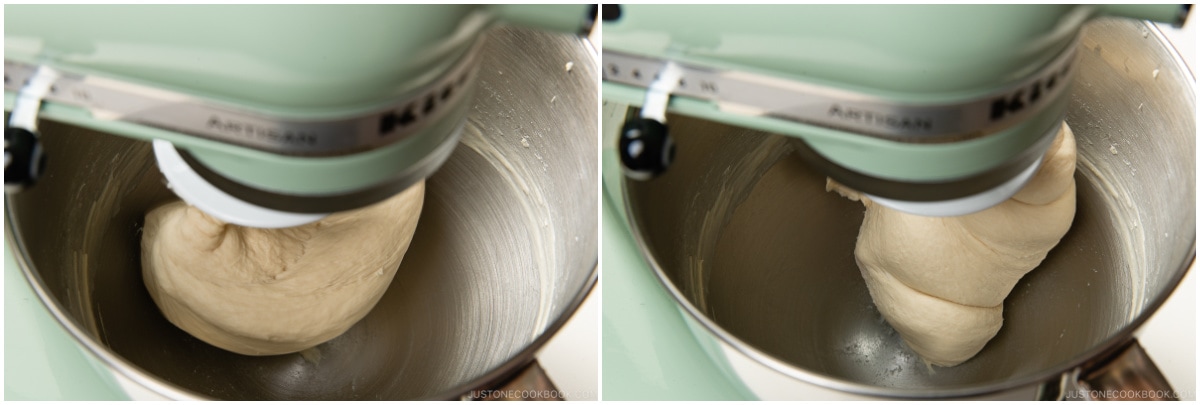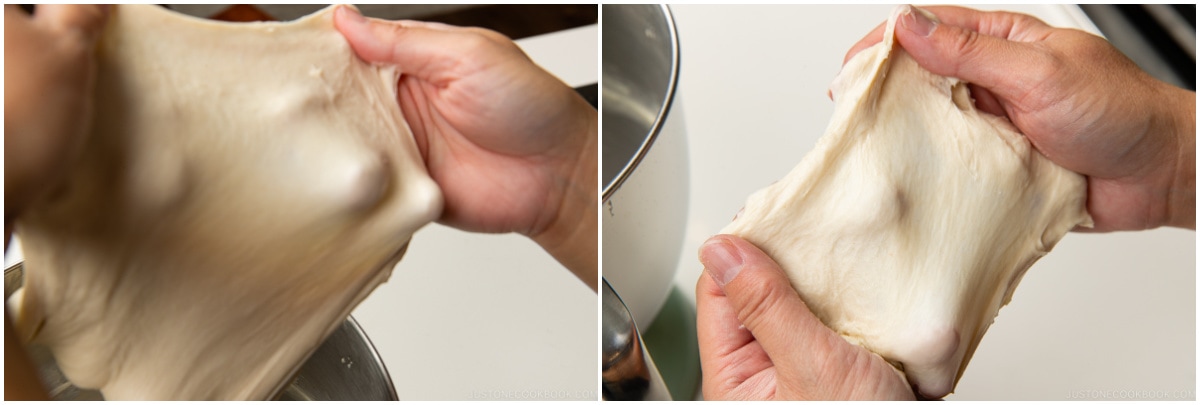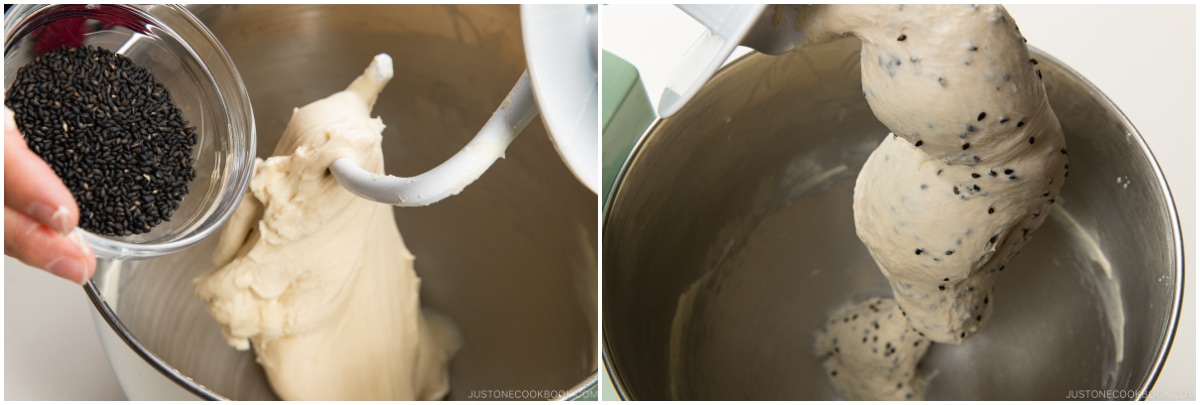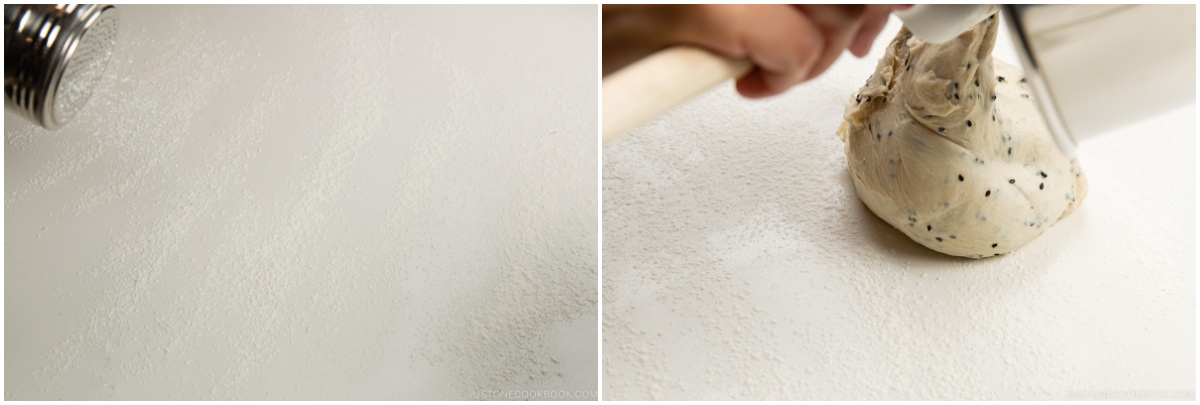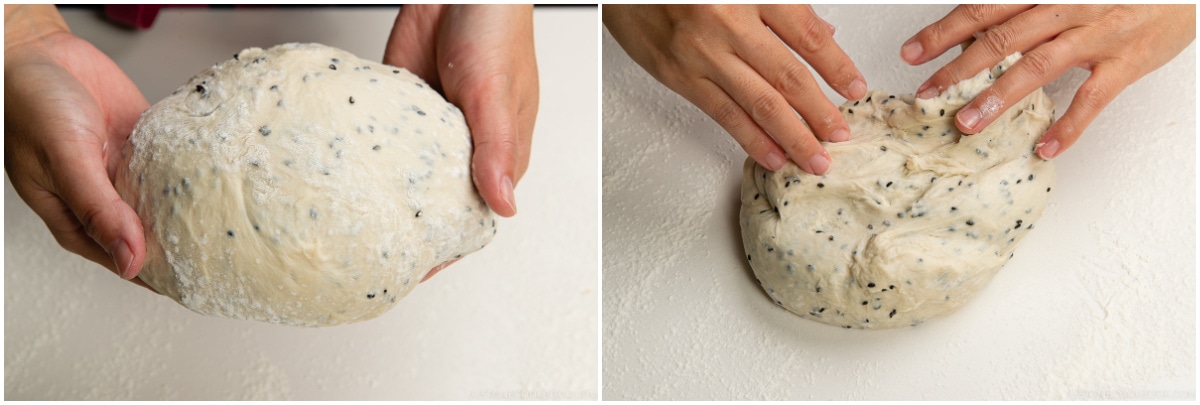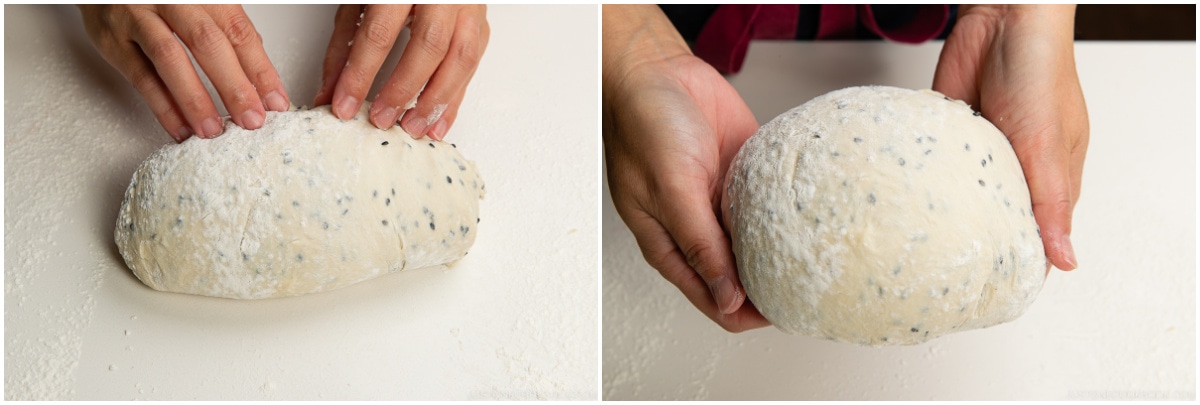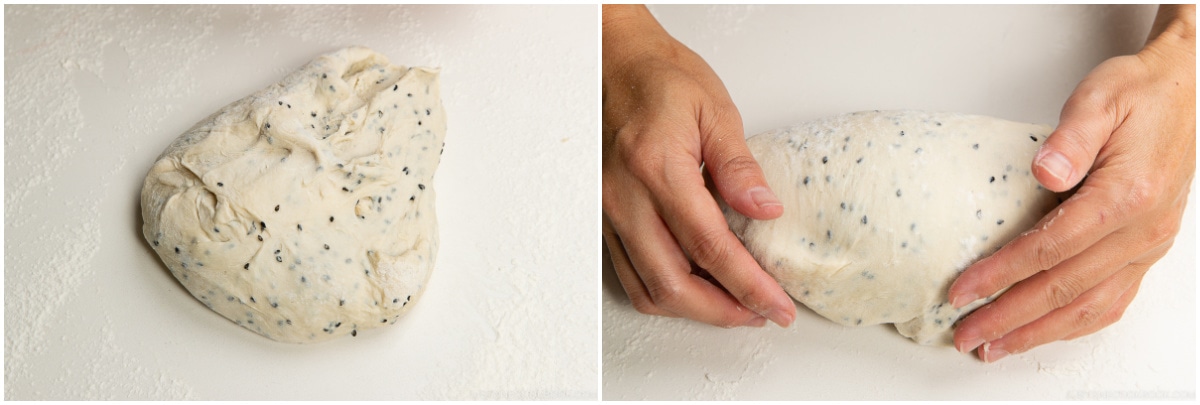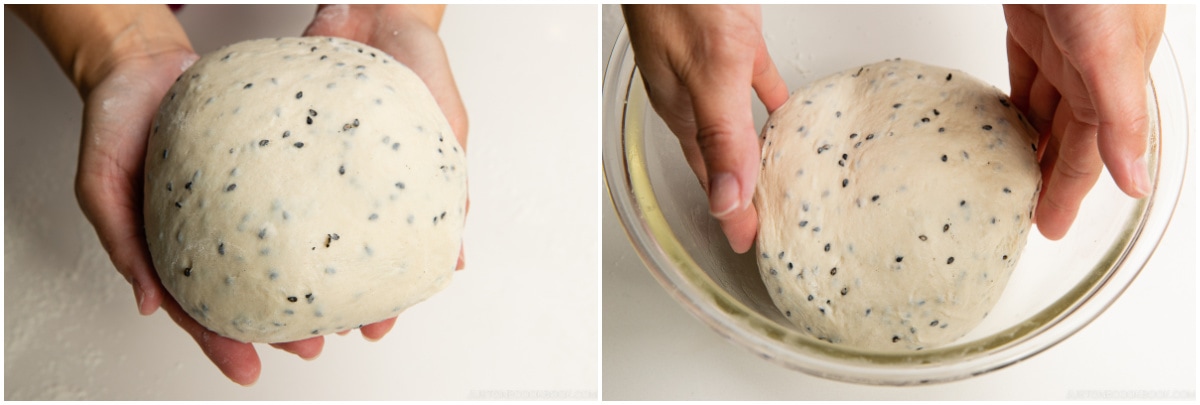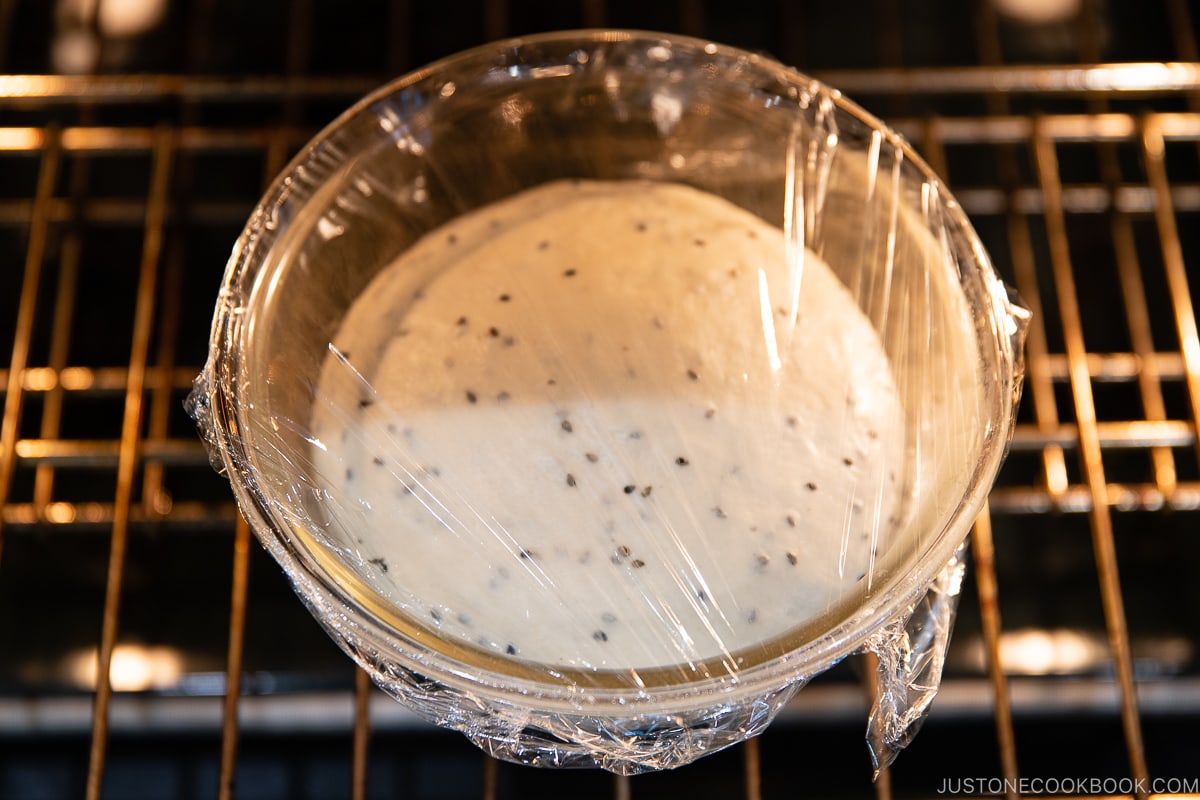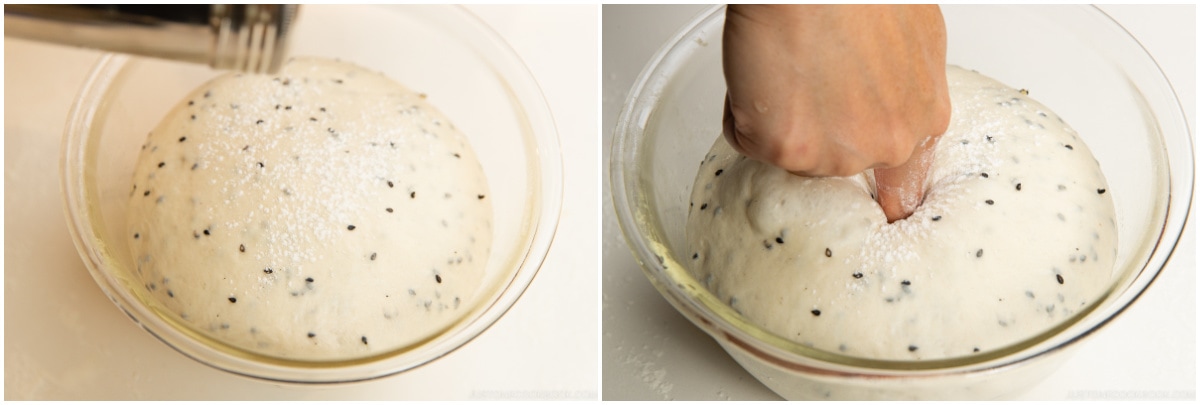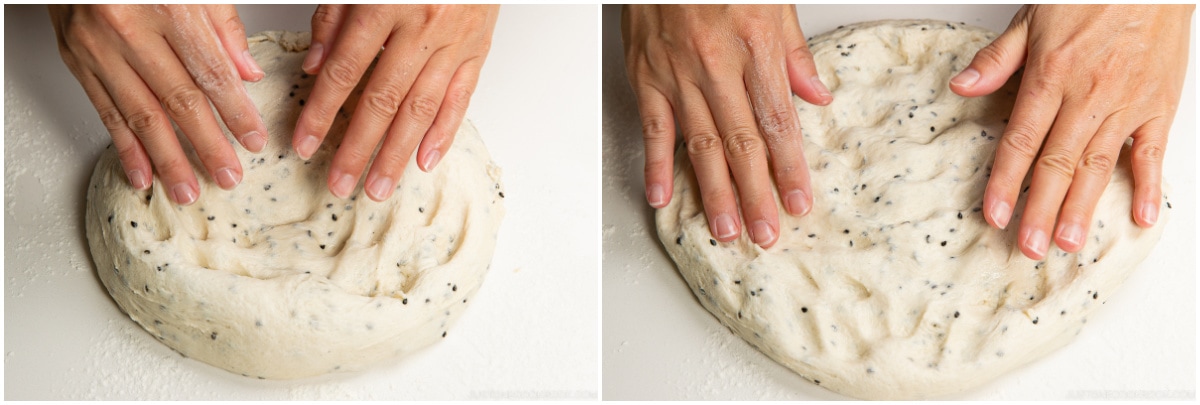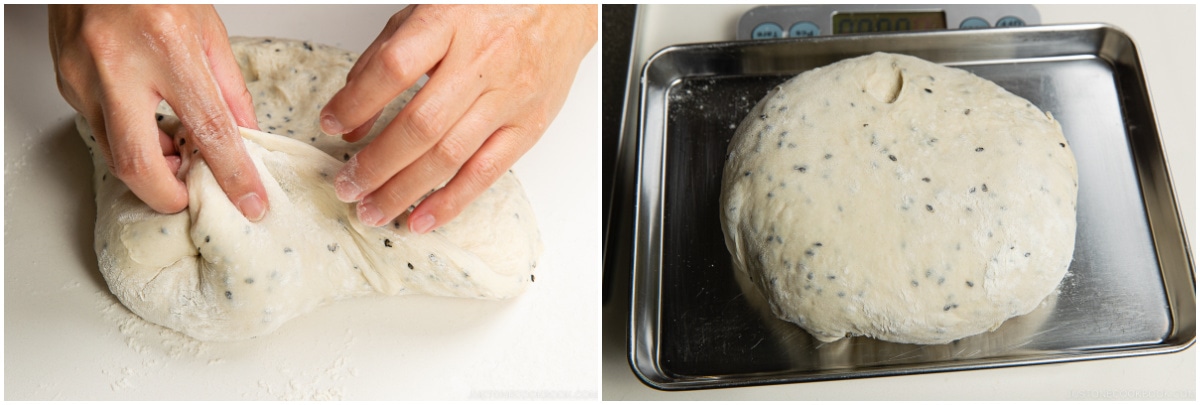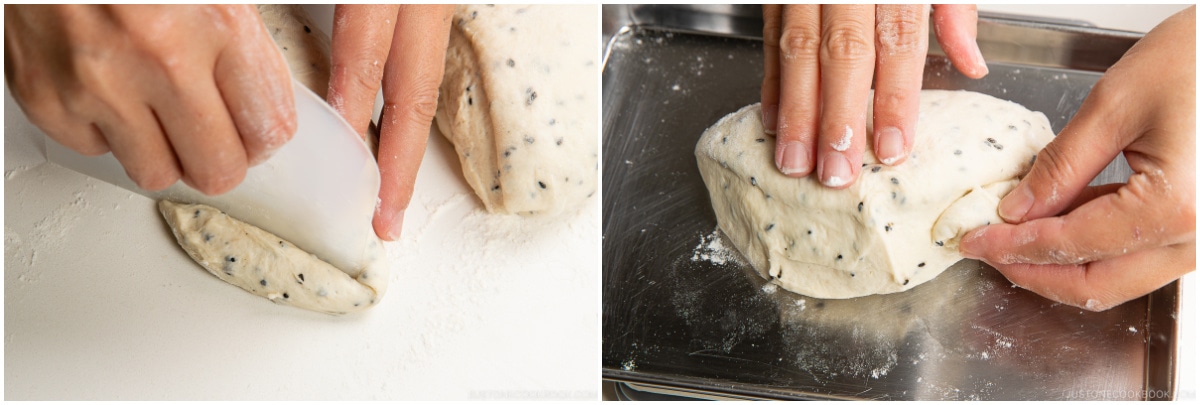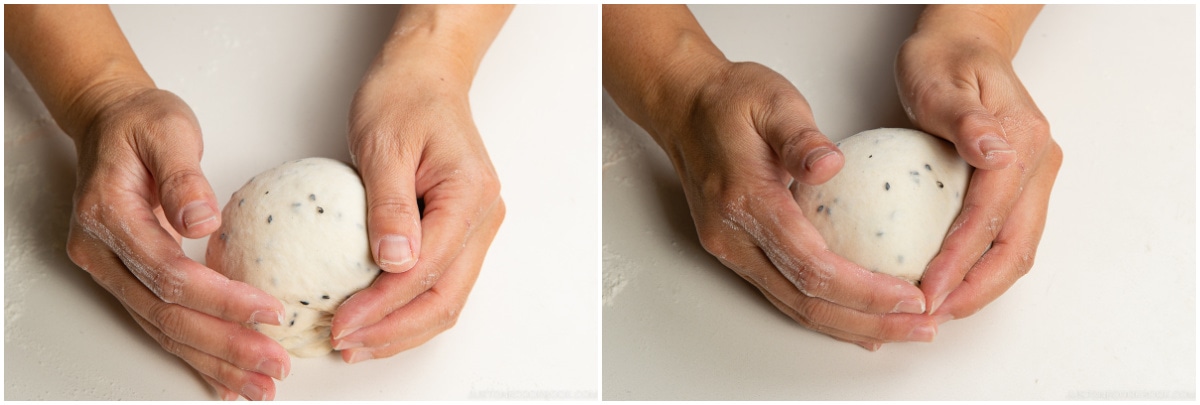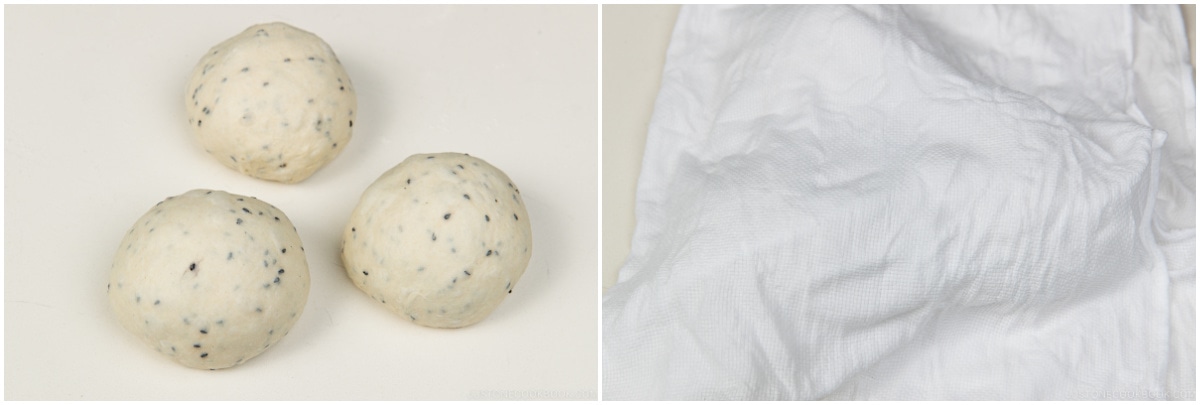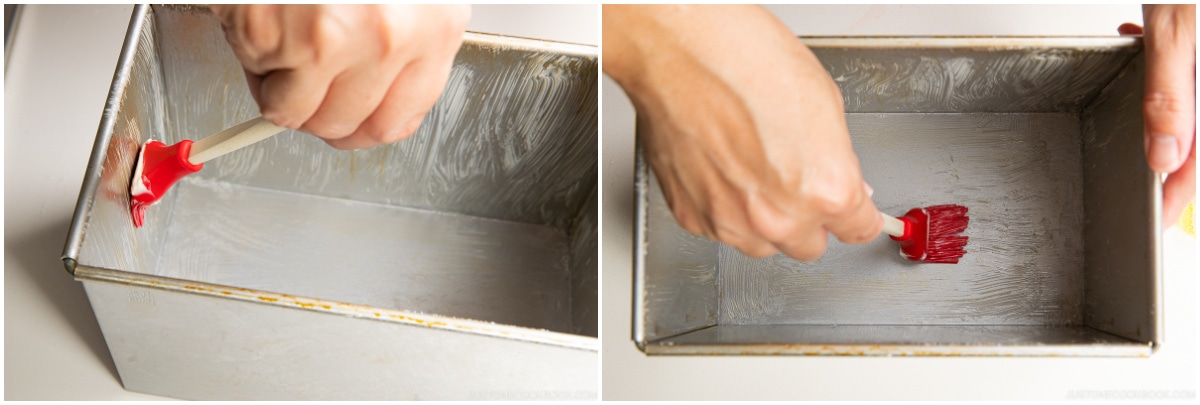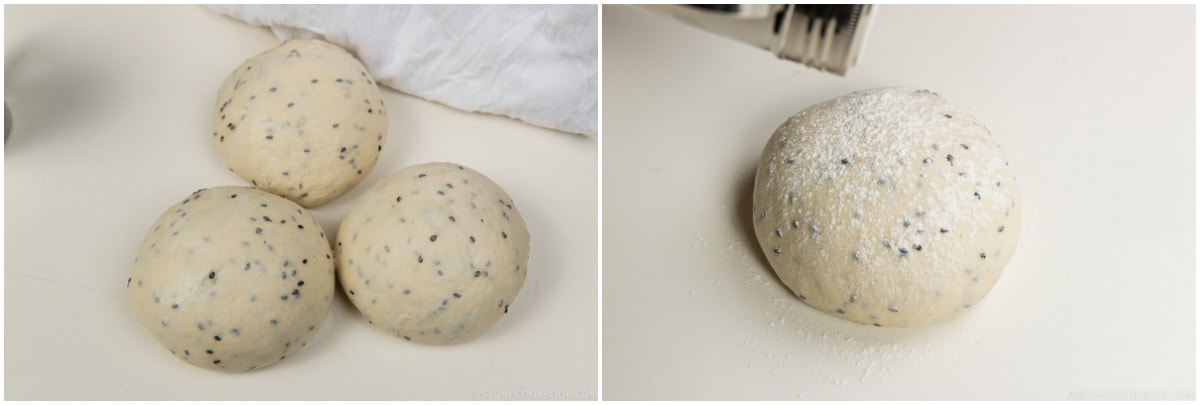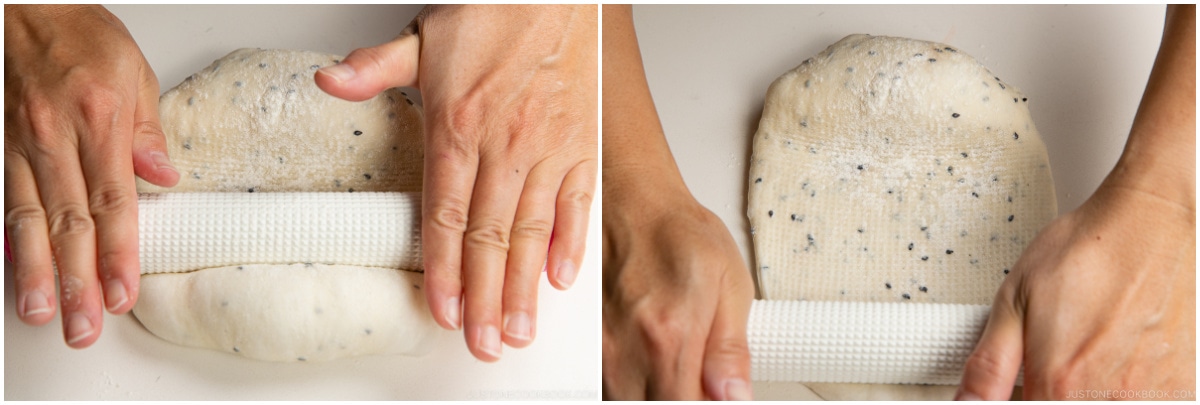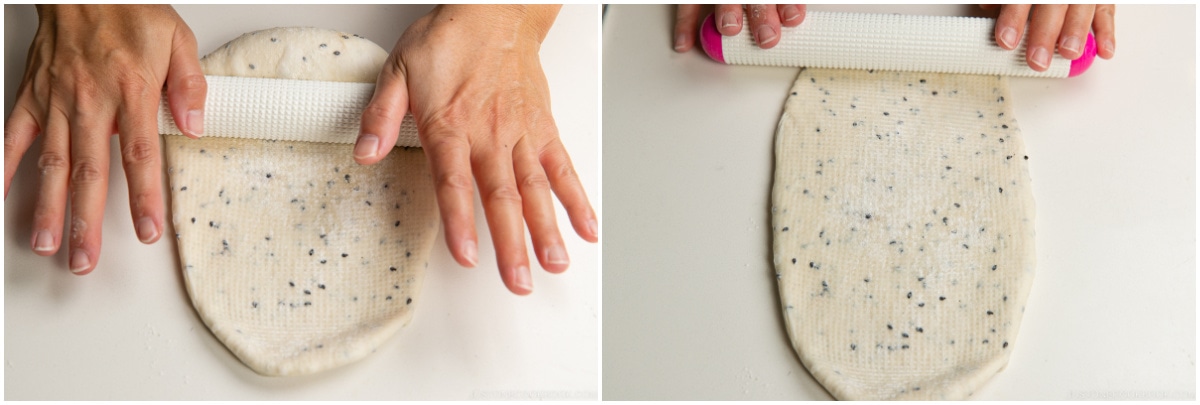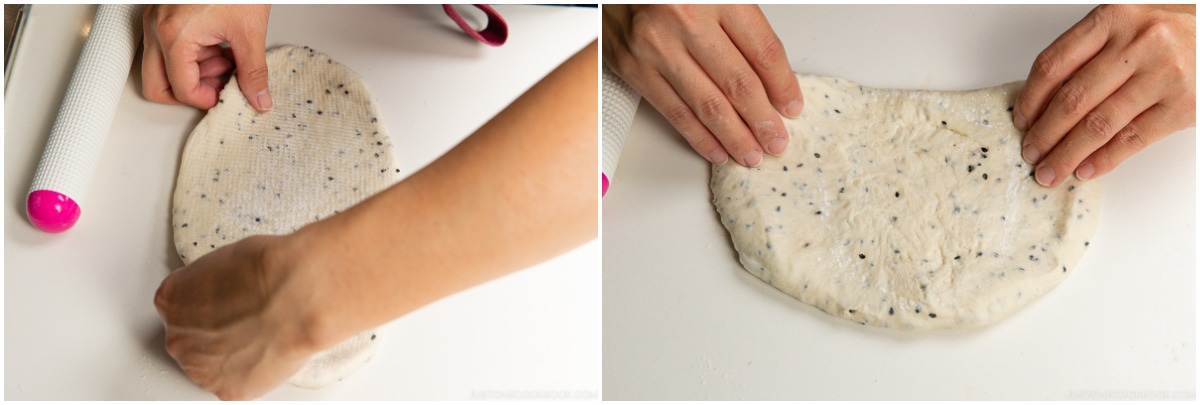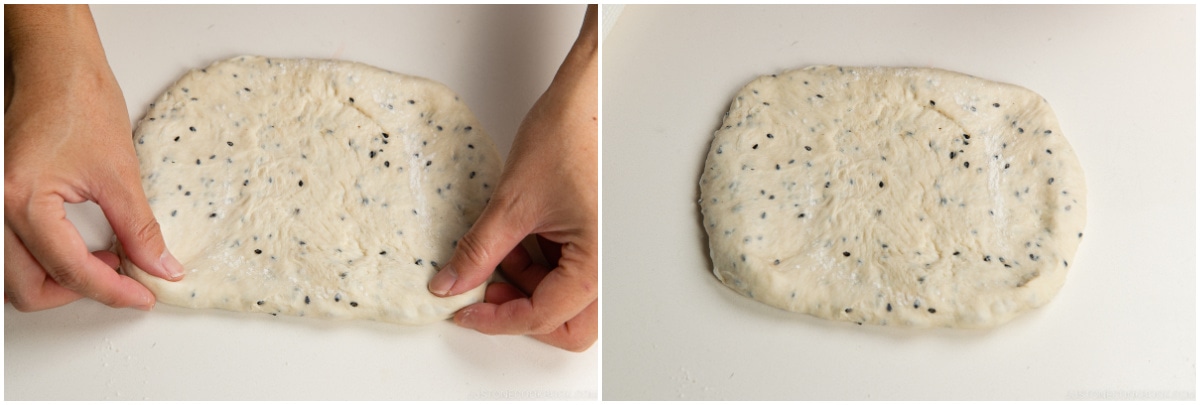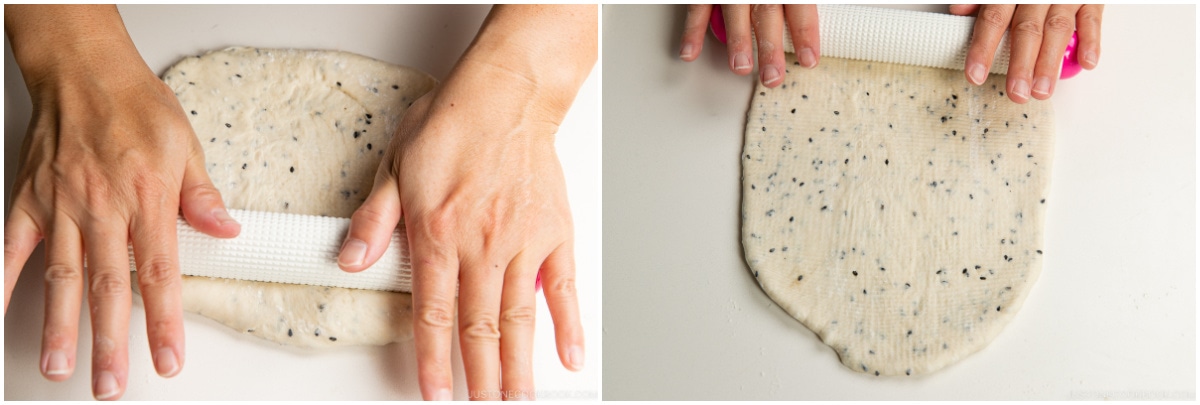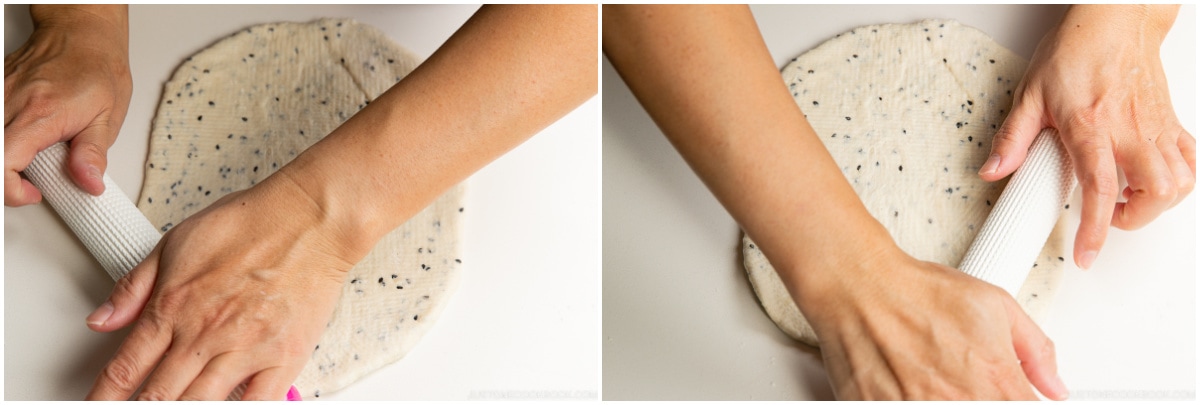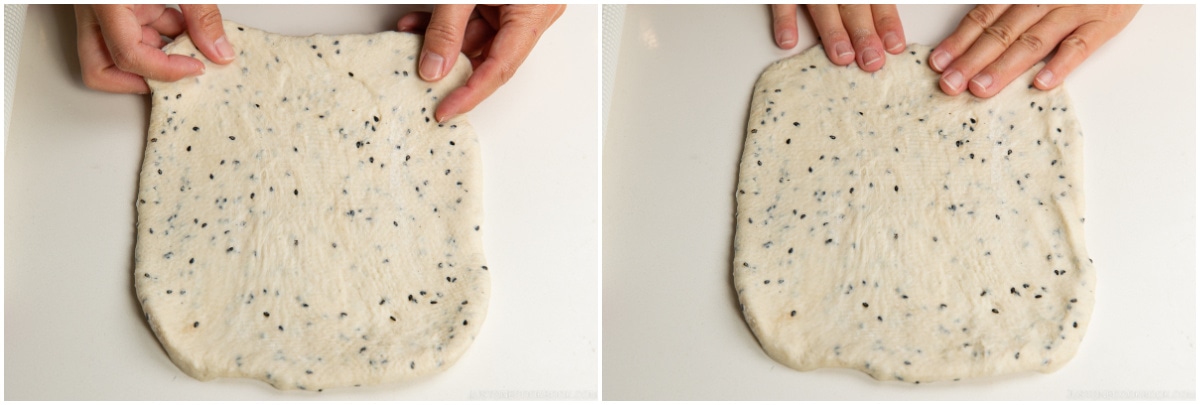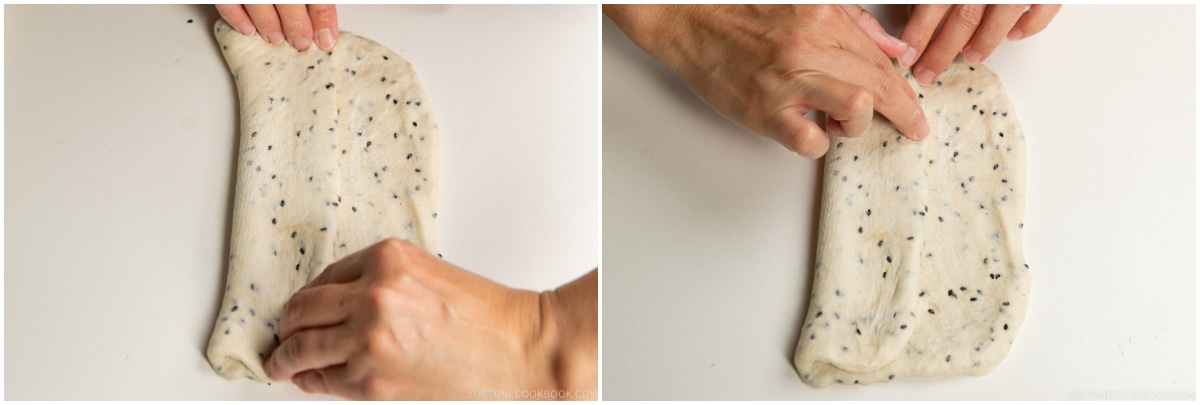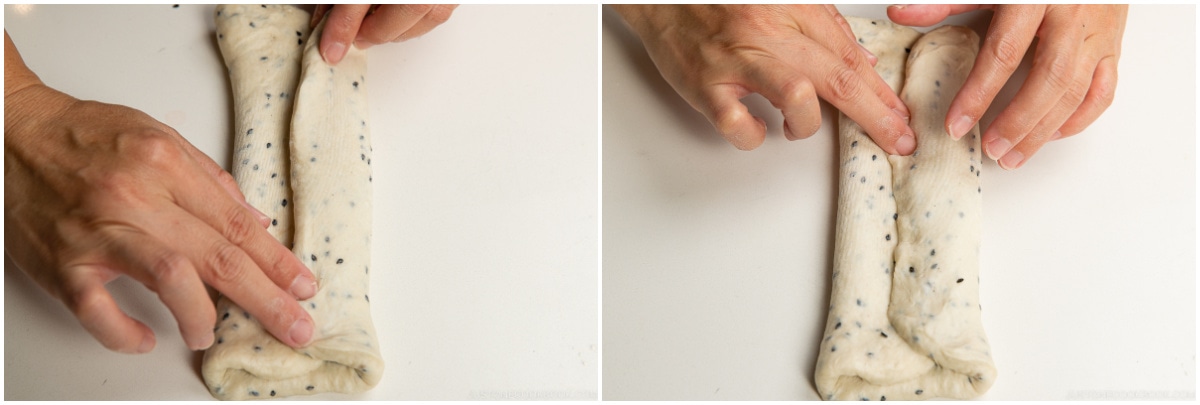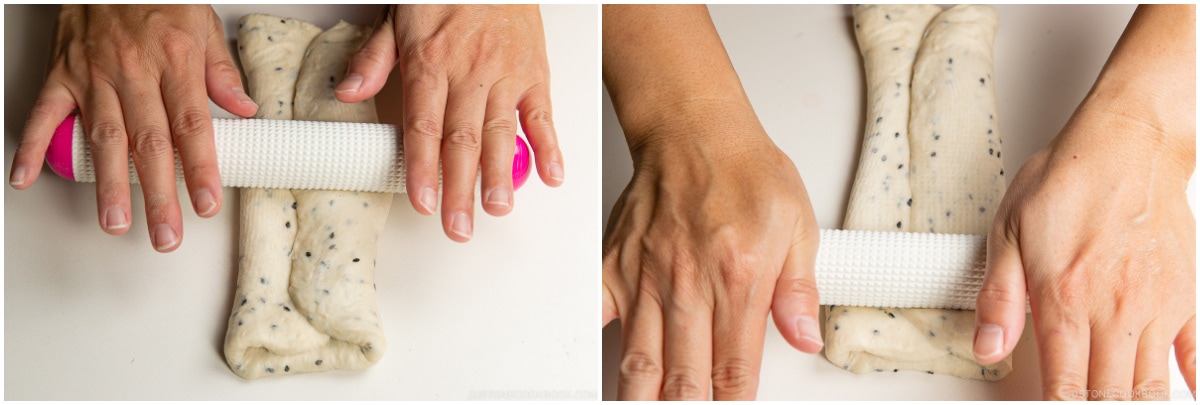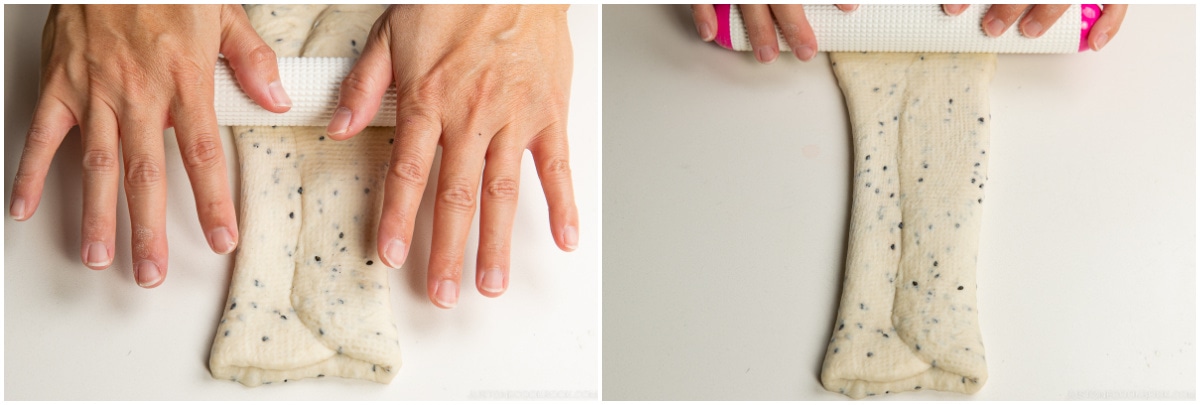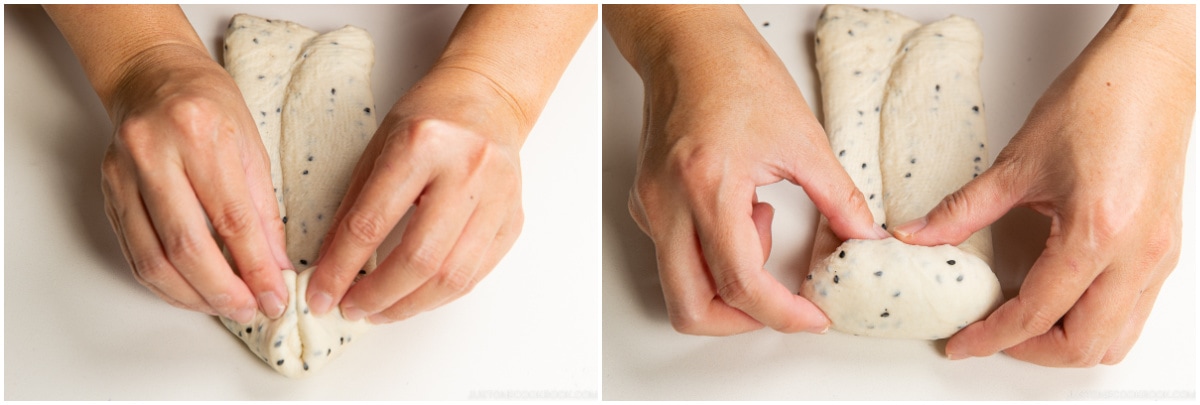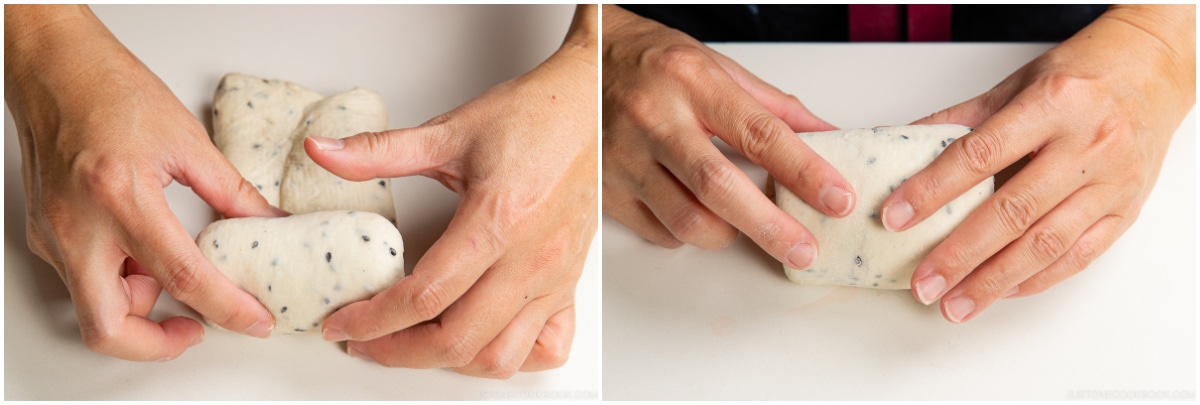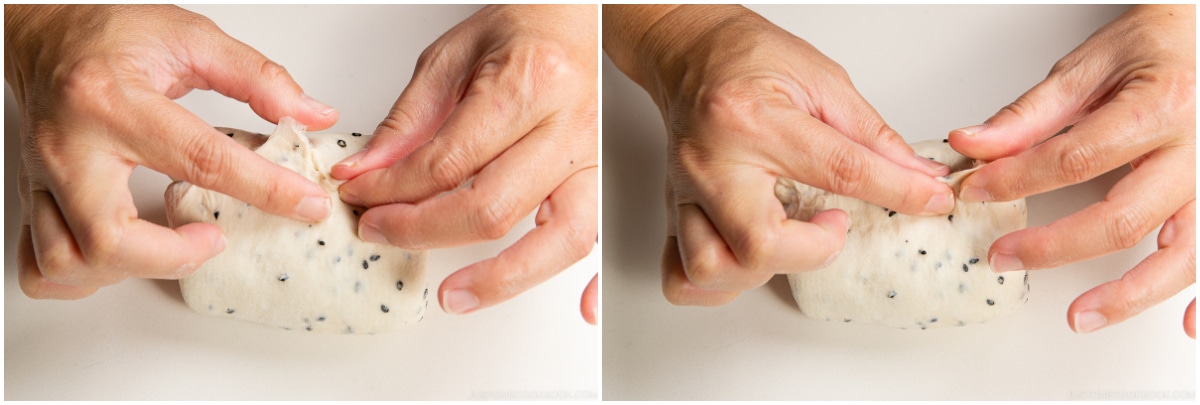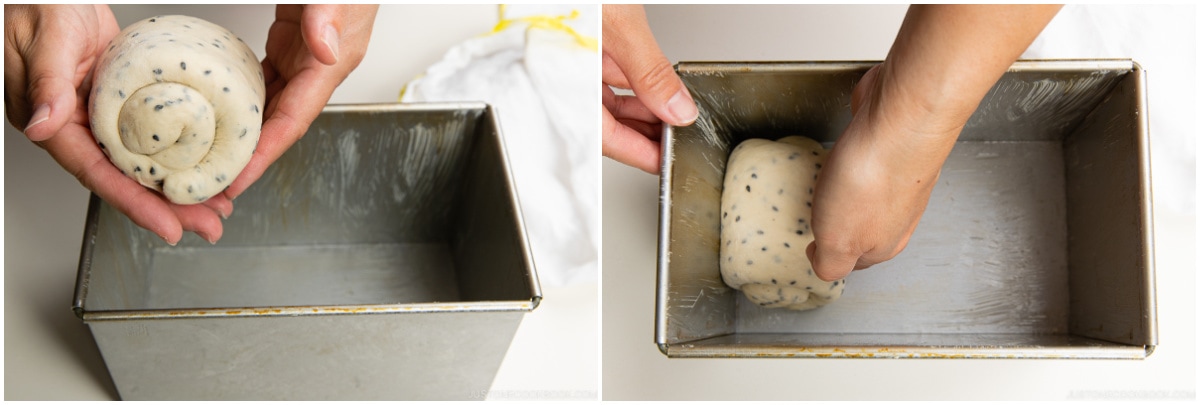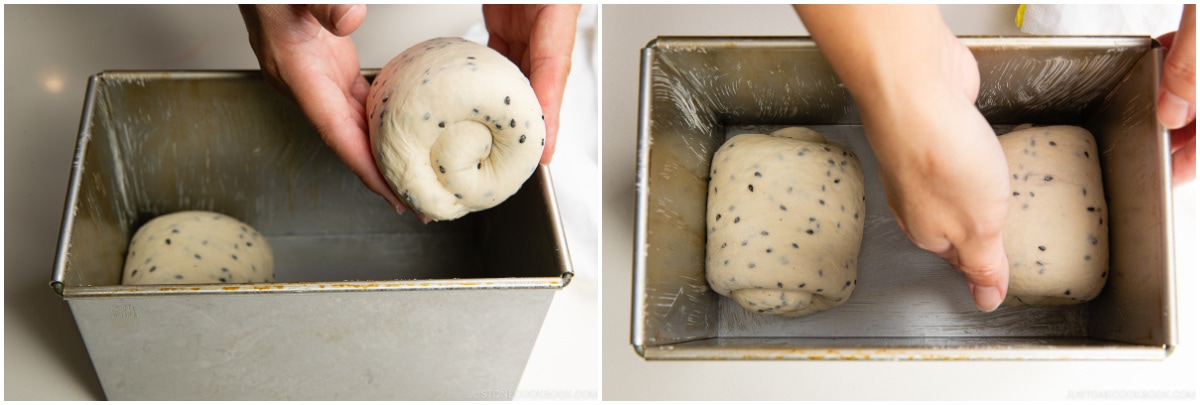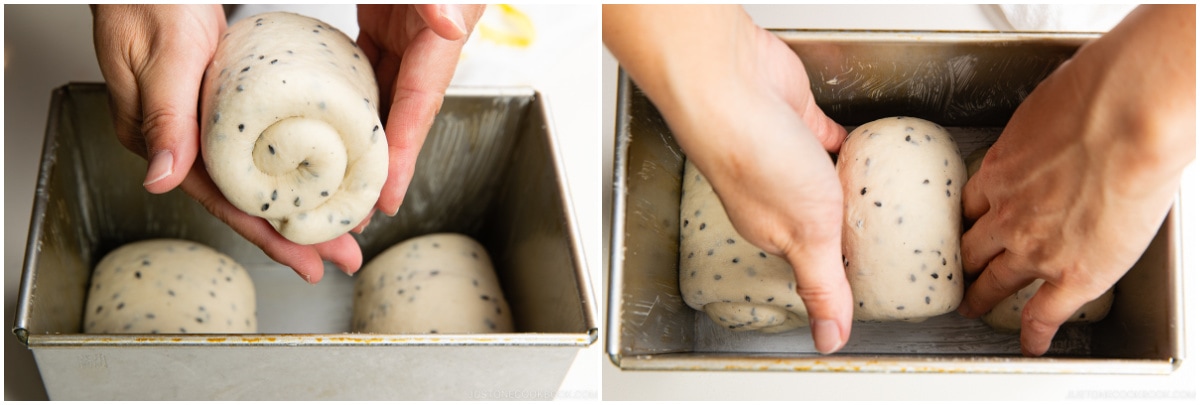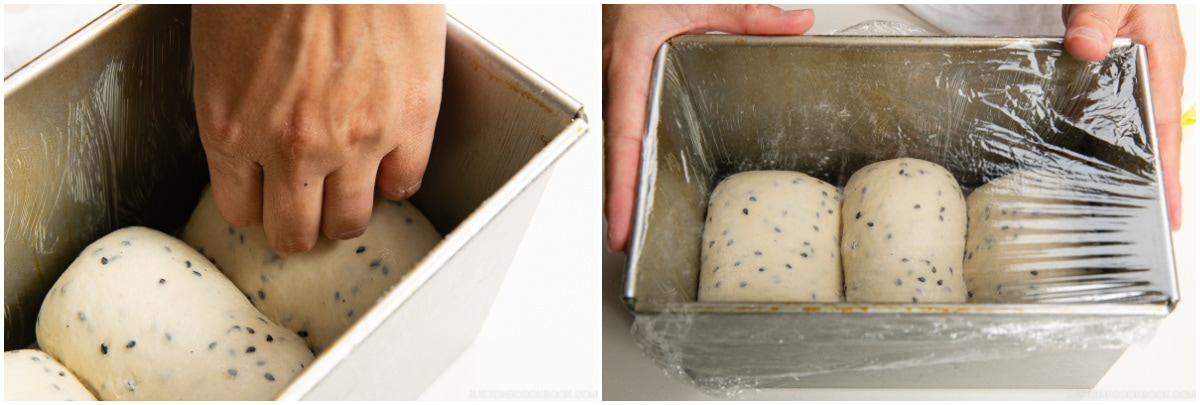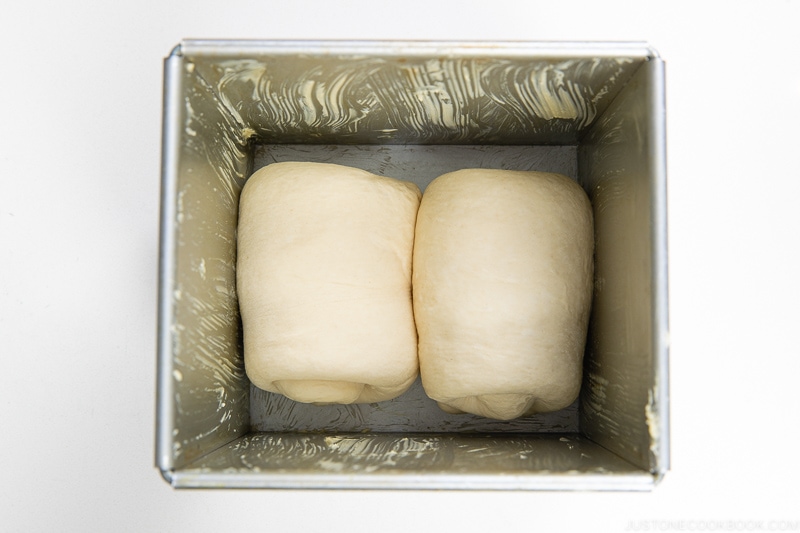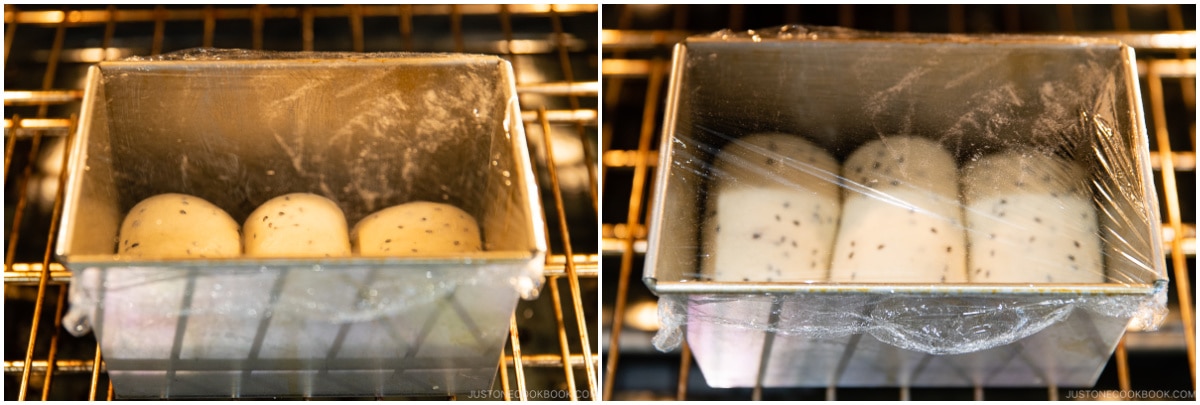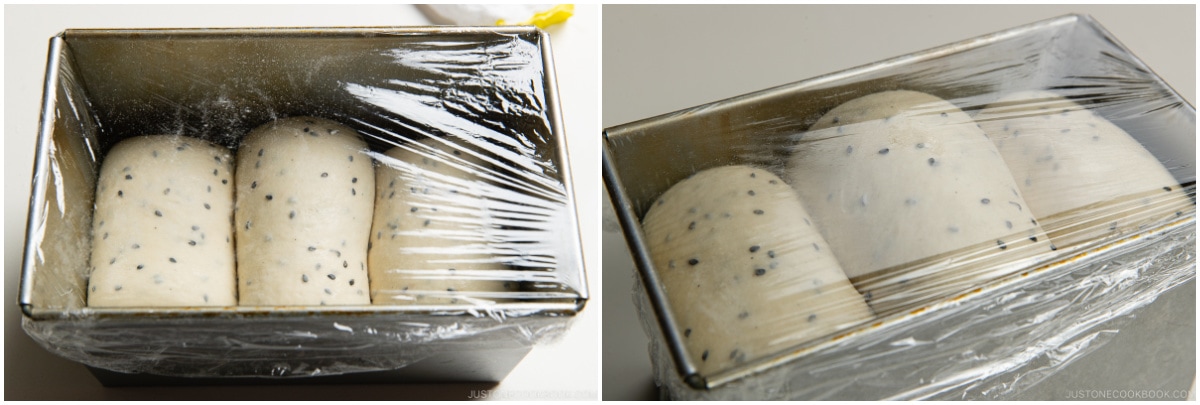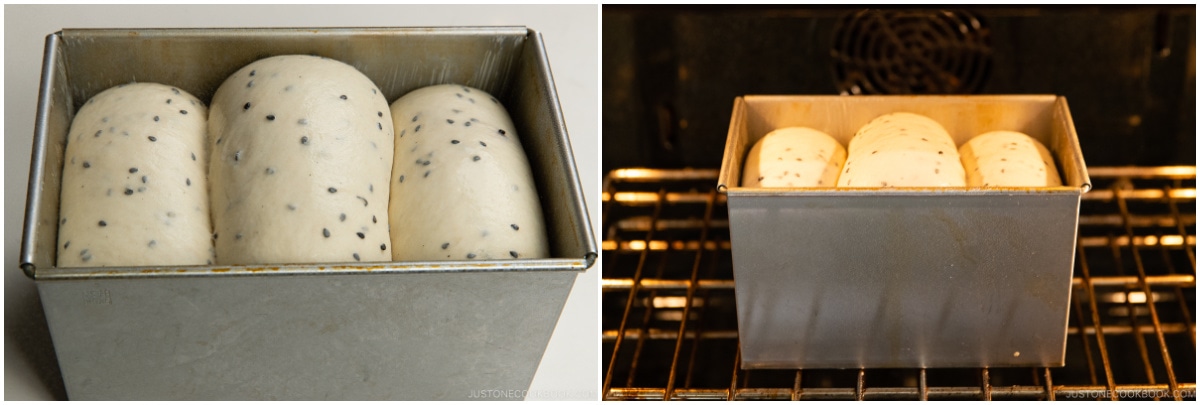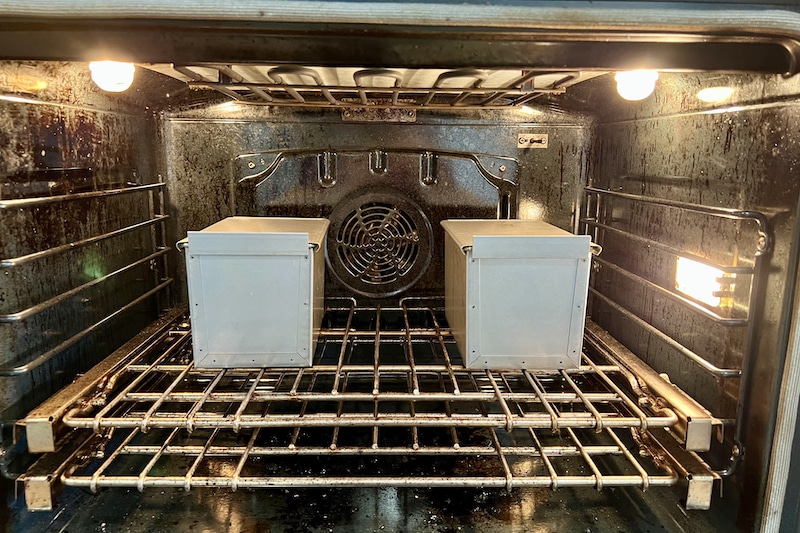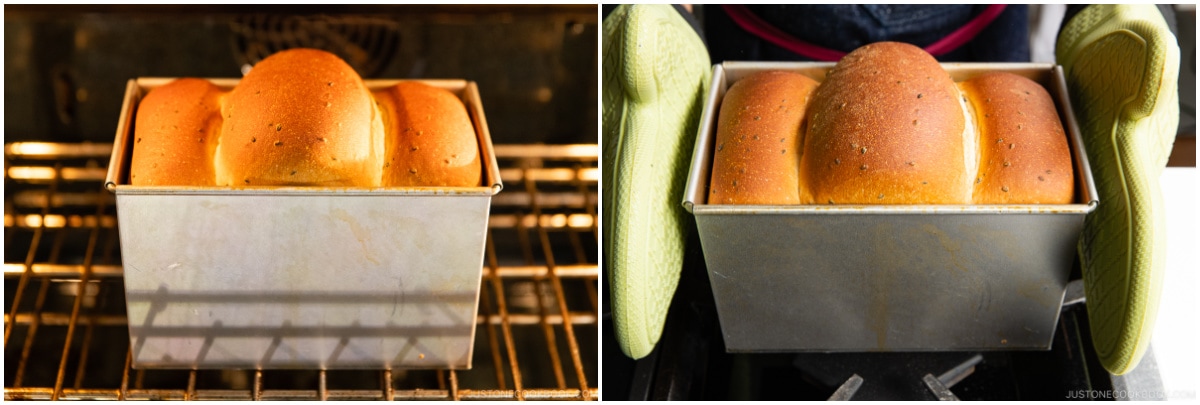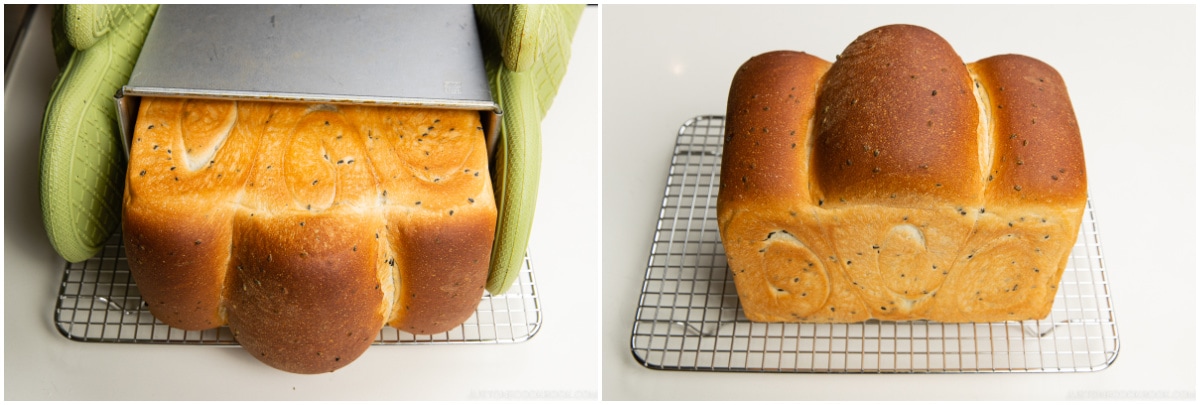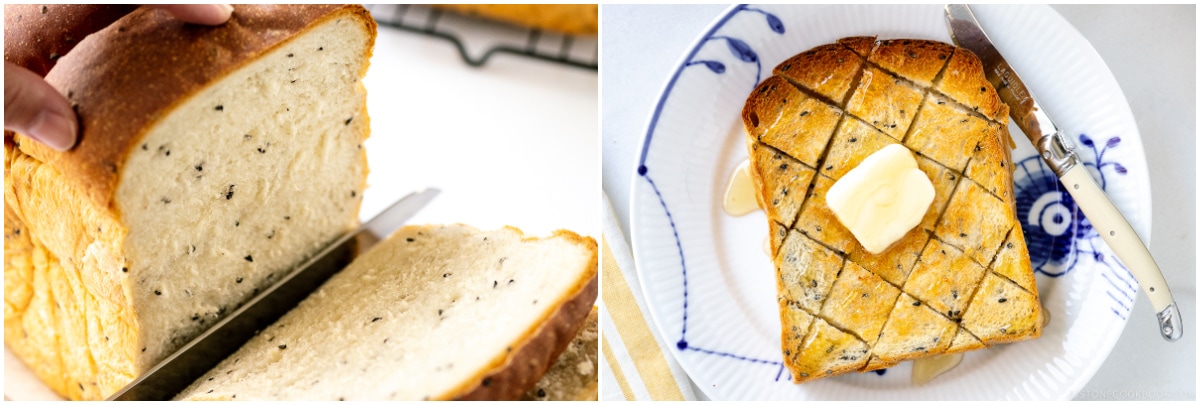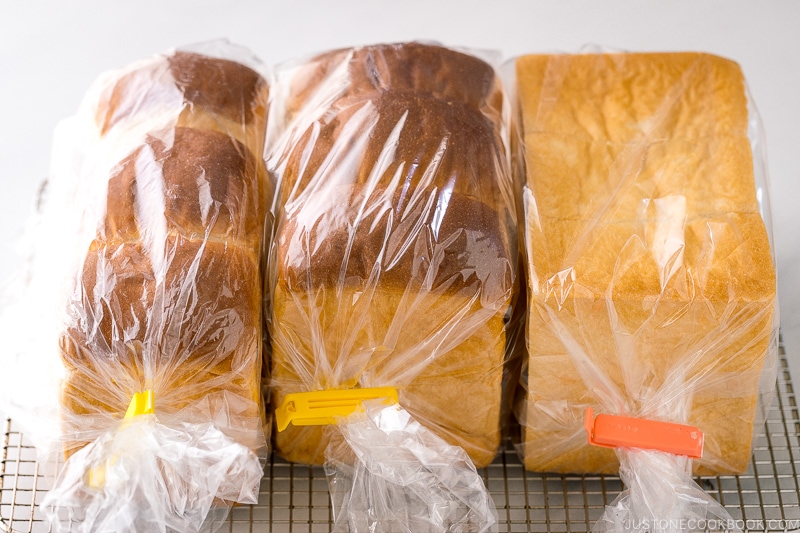I’m back with a popular variation of Japanese Milk Bread (Shokupan) – Black Sesame Milk Bread (黒ごま食パン). The earthy black sesame seeds stud the loaf with a nutty crunch and impart an amazing aroma, which is especially delicious for savory Japanese sandwiches. But it’s so good that you might want to devour it the moment the loaf comes straight out of the oven!
What is Shokupan?
Shokupan (食パン), or Japanese milk bread, is the most common style of Pullman loaf bread enjoyed in Japan. It is known for its cloud-like fluffy texture, thin gold crusts, and the milky sweet taste that melts in your mouth. Much like many iconic foods in Japan, shokupan can be both humble and elevated. You can find loaves of milk bread on the shelves of konbini (convenience stores) or at trendy cafes and bakeries that specialize in making shokupan in a variety of fun flavors. People would line up for hours just to get their freshest loaves. Today, shokupan is popular all over the world and I’ve seen a strong passion and interest among many bread makers and home cooks alike in making their own Japanese milk bread at home. Unbelievably squishy, moist, and buttery with just the right amount of sweetness, it is really hard not to adore shokupan.
My Japanese Milk Bread Recipe
There are many different methods of making shokupan. While many recipes follow the yudane or tangzhong methods, I use a much easier and more straightforward technique. You’re guaranteed the best loaf of milk bread in a shorter time. If you’re interested in the classic Japanese Milk Bread (Shokupan) recipe or want to learn more about this bread, please check this post.
Fun and Tasty Addition to Shokupan
I love the classic plain white shokupan, but I also enjoy a variety of fun flavors that can be added to the milk bread. Here are some popular ones you can make:
Black sesame seeds – today’s recipe Dried fruits (raisins, cranberries, figs, etc) – rehydrate by pouring hot water and pat to dry Nuts (walnuts) – roast and let cool before adding Sweet potatoes and kabocha – cut into small cubes and reduce the liquid for the dough as vegetables contain moisture Cheese – cut into small cubes Chocolate chips Corn
As a rule of thumb, the ideal amount of nuts and dried fruits is 20 to 30% of the dough. Add them when you’ve passed the windowpane test.
Baking Tools You’ll Need
Must-Haves
A Pullman loaf pan—I use both a rectangular loaf pan (4.7 in. x 7.8 in. x 5.1 in.) and a square loaf pan (4.7 in. x 5.3 in. x 5.1 in.). I’ll talk more about this below. KitchenAid Artisan Series (5 QT, 325 watts; I do not recommend the bowl-lift Professional Series with a spiral hook unless you double the rectangular loaf recipe) C-dough hook Digital kitchen scale* (I use this and LOVE it after trying three other brands) Large bowl Dough scraper (I use this) Rolling pin (I use this) Mister (for round-topped loaf) Wire rack Bread knife (I use this)
- Please weigh your ingredients with a kitchen scale as precise measurement is crucial for the success of this recipe. I strongly discourage using a cup or volume measurement.
Nice-to-Haves
Flour duster/shaker (I use this) Plastic bags for storing your loaf (I use this)
From Your Kitchen
Tea towel Plastic wrap
Where to Buy the Right Japanese Loaf Pan
To make shokupan following the standard Japanese size, I recommend this 1.5 kin loaf pan (4.7 in. x 7.8 in. x 5.1 in.) and/or this 1 kin loaf pan (4.7 in. x 5.3 in. x 5.1 in.) from Asai Shoten (浅井商店) in Japan. The loaf size in Japan is measured in “kin (斤),” an old Japanese unit for measuring bread weight. The British-style round-topped bread was 1 pound (450 g) back then and it was called “1 kin.” Now, how do you get a loaf pan shipped to your home from Japan? I have written an extensive post about Japanese loaf pans and how to order them from Japan.
How to Make Black Sesame Milk Bread (Shokupan)
You can make shokupan with very simple ingredients and procedures. I’ve made my fair share of shokupan, but there’s still plenty to learn and I may not know all the answers. If you wish to build a strong foundation and knowledge on how yeast bread works, I encourage you to take bread-making classes from my instructor Mariko.
Ingredients You’ll Need
(Baker’s percentages are in parentheses)
Warm water (71%): 104ºF or 40ºC Sugar (6%): I use organic cane sugar from Costco Instant yeast (2%): I use Fleischmann’s® bread machine yeast or RapidRise® instant yeast Kosher salt (2%) Honey (3%): I use multi-floral and clover honey from Trader Joe’s, but you can use other types Bread flour (100%): I use King Arthur bread flour, which is 12.7% protein–a whole point higher than other US brands Skim milk powder or nonfat dry milk powder (6%): Skim milk powder and nonfat dry milk are different. Skim milk powder has 34% in protein while nonfat dry milk powder has 18%. In Japan, shokupan is made with skim milk powder. Here in the US, you can only find nonfat dry milk powder and I’ve been using Bob’s Red Mill’s to make shokupan. Unsalted butter (7%): I use Kerrygold. Please DO NOT use salted butter Black sesame seeds
Substitutions:
To substitute active dry yeast for instant yeast: Some online resources say to use the exact same amount as instant dry, while others say to use 25% more active dry. So please give it a try and adjust. Proof active yeast by dissolving it in a portion of the warm water (105º-110ºF or 41-43ºC) from the recipe before adding to the rest of the ingredients. Use the following yeasts interchangeably: Instant yeast = RapidRise® yeast = quick-rise yeast = bread machine yeast. Can I substitute bread flour with all-purpose flour? No, please do not substitute if you want to make a proper shokupan loaf. You will need the higher percentage of protein in bread flour for the dough to rise high enough. Vegan milk powder option? I haven’t tried alternatives, but Mariko had tried coconut milk powder and it worked. Avoid soy milk powder as the dough does not rise well. Vegan butter option? Please use unsalted vegan butter such as Miyoko’s.
Overview: Bread-Making Steps
Total time: 3 hours and 35 minutes (+ cooling) / Active time: 1 hour and 10 minutes
5 Important Tips for Milk Bread Making
There’s a lot of information to take in but don’t let it deter you from giving shokupan a try. I have beginners who have tried making the classic milk bread with success! The tips are here to equip you with the basic science of bread-making so you’re off for a good start.
Tip 1: Create a Warm Environment for Your Dough
The optimal temperature for fermenting and proofing bread dough is 86-95°F (30-35°C) degrees. To create a warm environment, place a baking pan or dish of boiling water on the lower rack of the oven and place the bowl of dough on the upper rack. With the door closed, the oven stays warm and humid. Sometimes, even with just the light on, it gets nice and warm. Dough proofed at temperatures lower than 86ºF (30°C) will take longer to ferment or will go dormant. At higher temperatures, the yeast will expand more quickly than the gluten structure. If this happens, it won’t be able to keep up with the fermentation and the air bubbles will collapse. Also, avoid placing the dough in direct sunlight in the summertime as it gets too hot and develops a crust, even though it may seem like a warm location for proofing.
Tip 2: Use the Windowpane Test
The more you knead the dough, the stretchier it gets. But how do you know when to stop? That’s where the windowpane test comes in handy. It’s a useful way to check the elasticity of the dough, and here’s how to do it: Now you know that your dough is properly kneaded and the gluten is well developed. Dough with the right elasticity can hold gases in while it rises and stretches even more as it expands.
Tip 3: Create a Smooth and Taut Surface
When you roll and shape the dough, try to create a smooth, slightly taut skin on the outside. When you have a smooth, taut skin, the carbon dioxide generated during fermentation will not escape. As a result, the bread becomes plump and voluminous, and the baked shape is beautifully finished. Try one of these two methods for creating a smooth, taut dough ball:
Tip 4: Always gently handle the dough as if it is a baby!
Always handle the dough with slow, gentle movements. No pulling, no stressing the dough. You would damage it if you pull or tear the dough while you divide, roll, and shape the dough. With your gentle care, your bread will be even more delicious.
Tip 5: Keep the Desired Dough Temperature (DDT) in Mind [Advanced]
The key to achieving consistently great results in your bread baking is to bring your dough to the desired dough temperature (DDT), no matter what season or kitchen condition you are in. I’ll discuss DDT in the next section. The dough temperature after kneading should be 79-82ºF (26-28ºC) and not lower or higher than this temperature. The yeast will be most active at 82-95ºF (28-35ºC) during the First Rise (or Bulk Fermentation), so your goal is to bring your dough to the DDT by the time you finish kneading. If your dough temperature is higher than 82ºF (28ºC), let the dough slowly rise for the First Rise, instead of putting it in a Proof setting (100ºF/38ºC) or placing it in a warm place. You do not want to overproof the dough. Baking in the summertime can be challenging as the dough gets warmer than it should be. I will cover this topic later in the post.
Expert’s Tip: The Desired Dough Temperature (DDT)
The temperature of the dough affects the rate of fermentation and, in turn, the flavor and texture of the finished product. When the season changes, the temperature in your kitchen also changes. Even if you’re doing everything the same, the temperature difference could affect the result of your bread. Therefore, the key to achieving consistently great results in your bread baking is to bring your dough to the desired dough temperature (DDT), no matter what season or kitchen condition you are in. At professional bakeries, measuring the temperature of the ingredients is as important as weighing the ingredients. The DDT varies depending on the type of bread. For shokupan, the DDT range at the end of kneading is 79-82ºF (26-28ºC). Maintaining the temperature range will lead to the best flavor and rise in your shokupan. The yeast activity slows down at around 113ºF (45°C) and dies when the temperature rises above 140ºF (60°C). Professional bakers use a simple mathematical formula to calculate the temperature of the one variable they can control: the water. Because water accounts for a large proportion of the ingredients in making shokupan, having the right water temperature to start is the most important factor to bring the dough to the DDT. The formula is: (DDT x 3*) – room temperature – flour temperature – friction factor** = water temperature Examples at my kitchen in San Francisco:
Summer in ºF: (80 x 3*) – 72 – 70 – 14** = 84ºF (29ºC) Winter in ºF: (80 x 3) – 65 – 70 – 14 = 91ºF (33ºC) Summer in ºC: (27 x 3) – 22 – 21 – 8** = 30ºC (86ºF) Winter in ºC: (27 x 3) – 18 – 21 – 8 = 34ºC (93ºF)
*The number of variable temperatures (room, flour, and friction) other than water temperature that affects dough temperature **The friction factor in baking represents the amount of heat transferred to bread dough during mixing and kneading. Friction can raise the temperature of your dough significantly, so it needs to be taken into account when making dough-temperature calculations. The amount of heat generated by the specific mixing method varies.
For stand mixer kneading, use a temperature between 11ºF and 18ºF (6°C-10°C) – I used 14ºF (8ºC) as the friction factor. For hand kneading, use a temperature between 0ºF and 9ºF (0°C-5°C).
I used the professional bakers’ friction factor for shokupan, which I found on multiple Japanese resources. The range was given because it varies depending on the machine, the temperature of your palm, and the amount of time you knead. For a temperature difference conversion, you multiply ºC by 1.8 (9/5) to get ºF, or you multiply ºF by 0.55 (5/9) to get ºC. Thus a mixer friction factor of 14°F is equivalent to 8°C, not -10°C. How to Troubleshoot
If the dough temperature is lower than DDT: Let the dough rise for a little longer than the time specified in the recipe in a warm place. If the dough temperature is higher than DDT: You can either let the dough rise in a cool place for a short time or lower the dough temperature by putting it in the refrigerator for about 1-2 minutes, then taking it out and re-rolling it so that the temperature of the dough is uniform. When the dough temperature is high, it is easy to over-proof, resulting in bad flavor and fast deterioration.
Baking in Summertime
When you bake in hot summer weather, you have to make sure the dough will not over-proof. When the dough rises properly, the bread will have a good smell, taste, and texture. When the dough over-rise, it will not yield tasty bread. Here are 5 things you can do to prevent the DDT (Desired Dough Temperature) from rising too high on a hot summer day.
How to Store Shokupan
At room temperature: This is the best storage method if you consume the bread within 1-2 days. Put your loaf in this plastic bag and keep it in a cool place out of direct sunlight. I usually cut slices off the loaf as needed. On warm days, consume it within a day or store it in the freezer (make sure to slice first before freezing). In the freezer: If you can’t consume your bread within a day or two, freezing is the best choice. The bread can stay fresh for up to 2 weeks. Cut the loaf into slices before freezing. It’s typically recommended to wrap the individual slices in plastic wrap to avoid odor absorption and freezer burn; however, I try to minimize plastic use, so I do not individually wrap in plastic. It’s best to enjoy it soon. In the refrigerator: The cold air dries the bread; hence, refrigeration is not the best method.
Best Ways to Enjoy Black Sesame Shokupan
Simple toast: Score the shokupan slice in a pattern (see above) and toast it. Then, place a pat of butter on top and drizzle honey. If your bread was frozen, mist some water on the slice and toast it in a preheated oven. Sandwiches: Japanese Sandwiches, Tamago Sando (Egg Salad Sandwich), and Wanpaku Sando.
Wish to learn more about Japanese cooking? Sign up for our free newsletter to receive cooking tips & recipe updates! And stay in touch with me on Facebook, Pinterest, YouTube, and Instagram.
